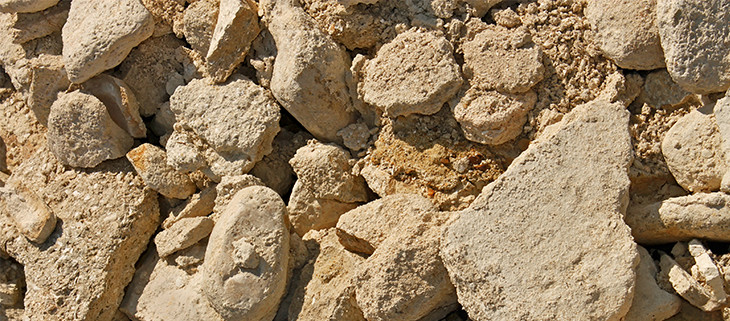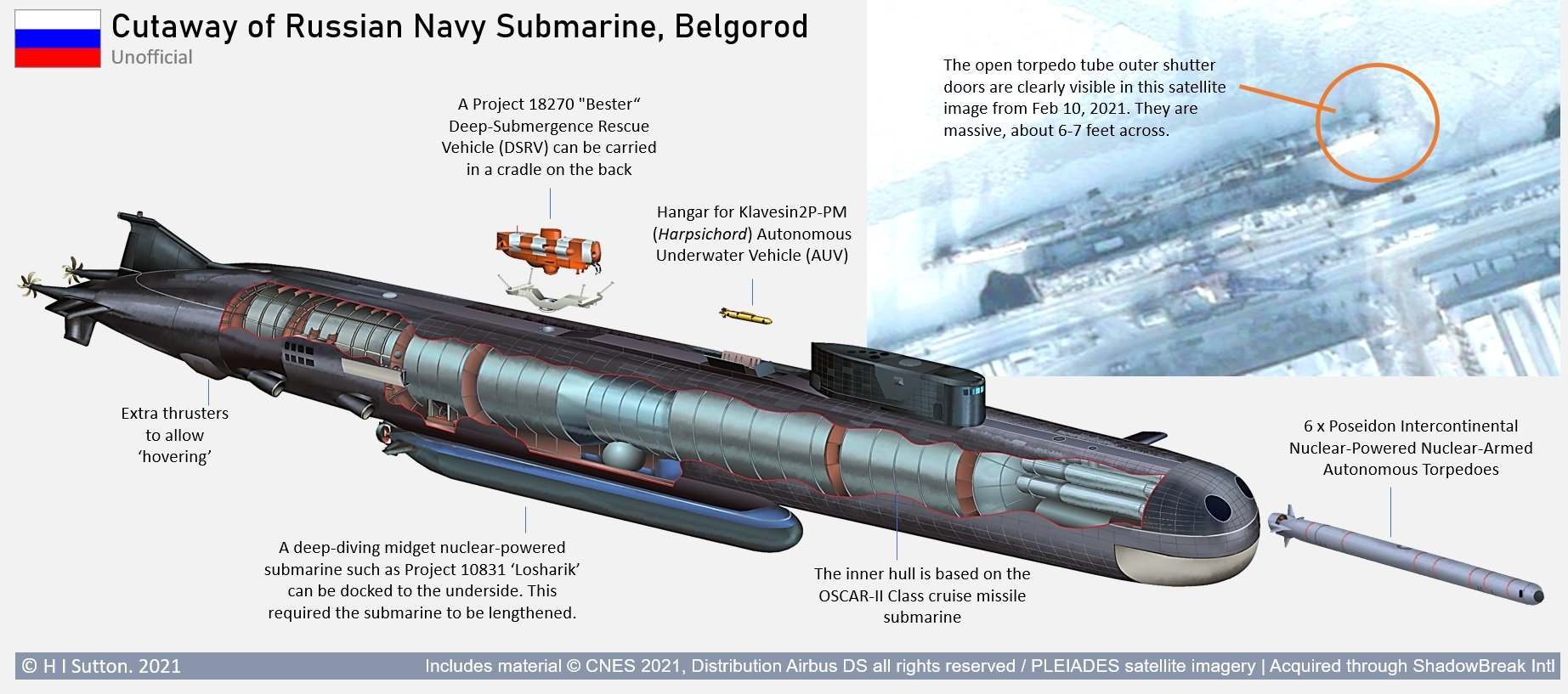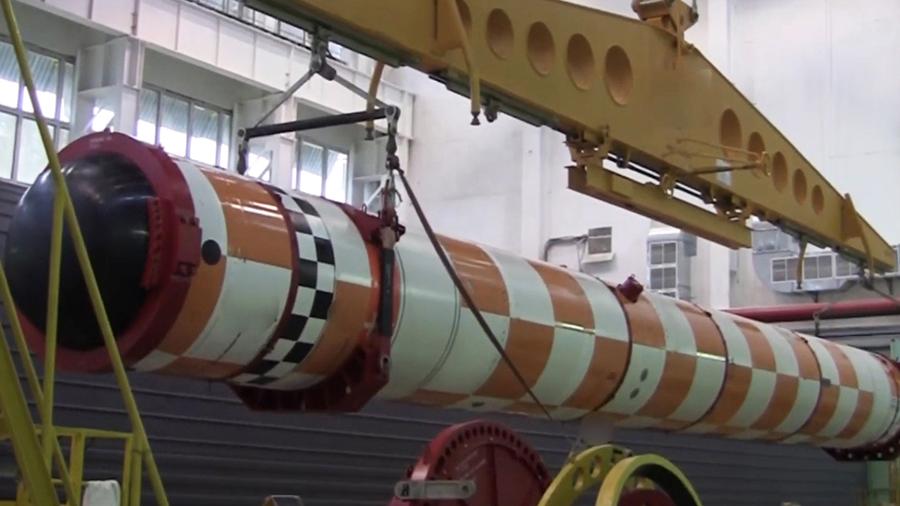Belgorod city (Russia) | Фотографии
Who are the good guys and who are the bad guys? Is there any truth in our media? Is it really possible that governments are perpetrating false flag disasters on their own people to promote their agenda? Are the Russians really standing for GOD and truth? Are the Russians really the evil enemy we have been taught all our lives to fear? Is Russia loosing the war? Are the Russian pilots inept and ill trained? Are Russian Weapons failing? Badly designed?
Our crazy world is totally UPSIDE DOWN! TOPSY TURVY. GOOD IS SEEN AS EVIL AND EVIL IS SEEN AS GOOD. Apparetnly, everything we ever learned has been a lie. Our governments, our media even our pastors have been lying to us. SO WHO DO WE TRUST AND WHAT SHOULD WE BELIEVE?
Some of my Christian friends have even said to me, “gosh, it looks like Putin is the good guy?” People have stated that they felt Putin was standing up for God and Truth. Seriously?
Most of us probably know very little about Russia. It is difficult to discern when you have no evidence. So, the Lord has been leading me on a discovery mission to uncover the TRUTH about Russia. I am, as usual, going to share what God showed me and you make your own judgements, decisions accordingly.
Is Russia the Agressor? Is Nato at fault? Is Biden itching to go to war? Is the Russian military totally inept? Are their weapons inferior and flawed? Is Putin Christian? Is Russia standing for Christ? Is Russia the King of the North?
spacer
| April 19- May 1 | Blood Sacrifice To The Beast. Fire sacrifice is required on April 19 is the first day of the 13-day Satanic ritual relating to fire– the fire god, Baal, or Molech/Nimrod (the Sun God), also known as the Roman god, Saturn (Satan/Devil). This day is a major human sacrifice day, demanding fire sacrifice with an emphasis on children. This day is one of the most important human sacrifice days |
| April 19 | Cerealia – Celebrates the beginning of the six vegetative months |
| April 21 | Parilia – Honored the pastoral god and goddess Pales, goddess of shepherds observed by driving sheep/cattle through burning straw/bonfires. first celebrated by the early kings of Rome, later by the pontifex maximus, or chief priest. The Vestal Virgins opened the festival by distributing straw and the ashes and blood of sacrificial animals. Ritual cleaning, anointment, and adornment of herds and stalls followed, together with offerings of simple foods. The celebrants jumped over a bonfire three times to complete the purification, and an open-air feast ended the festival. According to later tradition, April 21 was the day on which Romulus began building the city of Rome and was thus celebrated as the dies natalis of the cit / anniversary day of the city |
| April 21 -30 | GRAND CLIMAX (thru Apr 30) (Sexual and Blood Rituals) Abduction, ceremonial preparation & holding of sacrificial victim for Walpurgisnacht Oral, anal, and vaginal, and human sacrifice |
| April 22 | Earth Day |
spacer
In an unprecedented turn of events, the Russian Sukhoi-34 supersonic warplane accidentally fired a weapon, reportedly an aerial bomb, into Belgorod, located about 40 kilometers from Ukraine.
The incident, which occurred late on April 20, caused a massive explosionand injured about three people, with the actual number expected to be higher. The ordnance that accidentally fell on the Russian city left a 20-meter-deep crater and caused a massive explosion that blew a car onto a rooftop. (right in the center of town, it is a miracle there were no deaths or serious injuries. But, there was FIRE!)
Video footage of the accident site showed several damaged cars, concrete piles on the street, and a building with broken windows. The incident caused a deep-seated panic among the residents of the city.
Governor of the Belgorod area, Vyacheslav Gladkov, declared a state of emergency overnight stating that there were damages to four cars and four residential structures. “Thank God there are no dead,” he said in a statement on Telegram, adding that an apartment building had been evacuated overnight.
In a CCTV footage obtained in the aftermath of the accident, several automobiles are seen passing a crossroadbefore something fell on the ground close by. No immediate explosion occurs. About 18 seconds later, the ordnance explodes, destroying a portion of the road, hitting one of the passing vehicles, and launching a parked vehicle into the air.
To understand what could have caused the accident, EurAsian Times spoke to military experts. Group Captain Johnson Chacko (retd) explained, “There may be certain emergency situations when jettisoning of external load is resorted to for the safety of the aircraft. One of them could be an engine failure where the remaining thrust is inadequate for maintaining level flight, especially at low altitudes and low air speeds.
“Another could be when there is a threat, and external loads are jettisoned for better maneuverability for air combat, as the PAF did in operation Swift Retort post-Balakot. The bombs fell in an unintended area, causing no damage.”spacer
A similar observation was made by Indian Air Force veteran and military commentator Squadron Leader Vijainder K. Thakur, who told EurAsian Times, “The need to jettison stores can arise on several counts, one of them being an aircraft emergency such as a single engine failure. Another reason could be aerodynamic instability caused by the weapons store.For example, the wings of a glide bomb may accidentally deploy before weapon release. There can be other reasons also.”

Embarrassment For Russia, Celebration For Ukraine
The Russian Ministry of Defense (MoD) said while completing a flight above Belgorod in southwest Russia, a Su-34 aircraft of the Russian Aerospace Forces experienced an emergency ejection of air ordnance, TASS News Agency reported.
The ministry notified, “At around 22:15 Moscow time on April 20 (4/20 22:15 or 22222 6) ,when a Su-34 plane of the Russian Aerospace Forces was performing a flight above the city of Belgorod, an emergency release of an air ordnance occurred.” The Kremlin has given no new updates at the time of writing this report.
As the visuals of the incident surfaced on social media, netizens began to mock the incident calling it a work of karma for Russia, which regularly bombs Ukrainian cities, causing widespread devastation and leaving many dead.
|
|
In an official tweet, the Ukrainian Ministry of Defense said: “One should not laugh at the fact that the Russians dropped an aerial bomb on their city. Every day, Russian bombs fall on Ukrainian cities. Even such a heinous error will not teach or deter the Russians until they are stopped. We can do it together.”
The incident comes when the Ukrainian military has complained that it is virtually defenseless against Russia’s aerial bombs. With a new type of aerial guide bomb weighing 1.5 tons,Russia claims that Ukrainian air defense forces cannot shoot down these smart munitions. This was confirmed by the speaker of the Air Force of the Armed Forces of Ukraine, Yuriy Ihnat.
The Russian Aerospace Forces have extensively deployed these aerial bombs to attack assets inside Ukraine, often from a stand-off distance.
Further, while the latest incident has left the Russians red-faced, it may not be the first time that a Su-34 was in an embarrassing incident.In October last year, the Russian Defense Ministry stated that one of its Su-34 fighter bombers crashed in Yeysk in southern Russia after one of its engines burst into flames.spacer
This was another incident where the cutting-edge fighter of the Russian Air Force ended up killing the Russian people instead of attacking a target inside Ukraine.
The MoD said that an investigation was launched to decipher the cause of the accident. Military observers believe that the admission of the accident is an embarrassment to the Kremlin, which has pulled all strings to create a positive opinion of its so-called Special Military Operation (SMO) against Ukraine.
spacer
| April 19- May 1 | Blood Sacrifice To The Beast. Fire sacrifice is required on April 19 is the first day of the 13-day Satanic ritual day relating to fire – the fire god, Baal, or Molech/Nimrod (the Sun God), also known as the Roman god, Saturn (Satan/Devil). This day is a major human sacrifice day, demanding fire sacrifice with an emphasis on children. This day is one of the most important human sacrifice days
Cerealia – April 19. Celebrates the beginning of the six vegetative months |
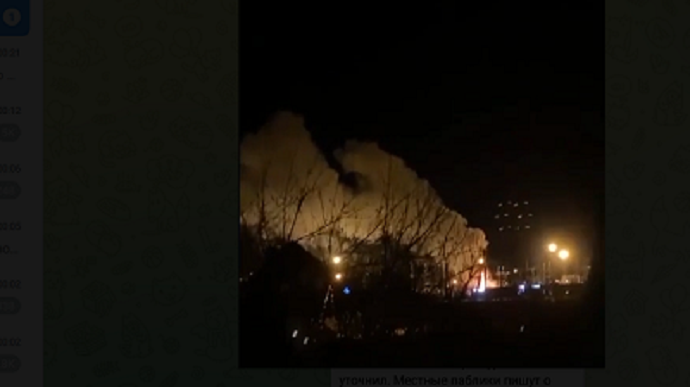
Social media users in Russia have reported that a drone exploded in Belgorod; according to some of them, the drone hit a power substation.
Source: BBC Russian service; social media; Vyacheslav Gladkov, Governor of Belgorod Oblast, Russia
Details: In particular, the Bletgorod Telegram channel has posted a video of what it claims was a fire caused by a drone strike.
LINK: https://t.me/belgorod_informant/3729
LINK: https://t.me/bletgorod/5636
The BBC Russian service has noted that some sources have reported a strike on a thermal power plant, while others have reported a strike on a substation.
In addition, most Russian sources have stated it was a Ukrainian drone.
Update: Gladkov later reported that two fires had broken out in Belgorod Oblast, Russia.
Quote: “Two fires occurred at civilian facilities in [the city of] Belgorod and in the Belgorod district. There were no casualties. Emergency response services have been deployed, and the fire is being extinguished.”
Ukraine-Russia war – live: Over 3,000 evacuated in Russian city after undetonated bomb found
Thousands have been evacuated from their homes in the Russian city of Belgorod after an undetonated bomb was found.
Over 3,000 people were evacuated on Saturday two days after Russia accidentally dropped a bomb on the same city, which is located about 25 miles from the border with Ukraine.
It is not known if the bomb came from the same aircraft. However, the undetonated device was found in the same area as the bomb that was accidentally dropped on Thursday evening.
Local governor, Vyacheslav Gladkov said that 17 apartment buildings had to be cordoned off “within a radius of 200 metres” of the undetonated bomb.
At least two people were injured after the bomb was dropped on Thursday evening, which left a crater of about 20 metres wide.
Buildings were destroyed and a car was blown on to the roof of a nearby shop.
The Russian defence ministry admitted that one of its fighter jets had “accidentally discharged aircraft ordnance” over the city.
Key Point
- Vladimir Putin ‘struggling to maintain narrative’ justifying war in Ukraine
In the Belgorod region, after a forced landing, the drone of the Armed Forces of Ukraine exploded
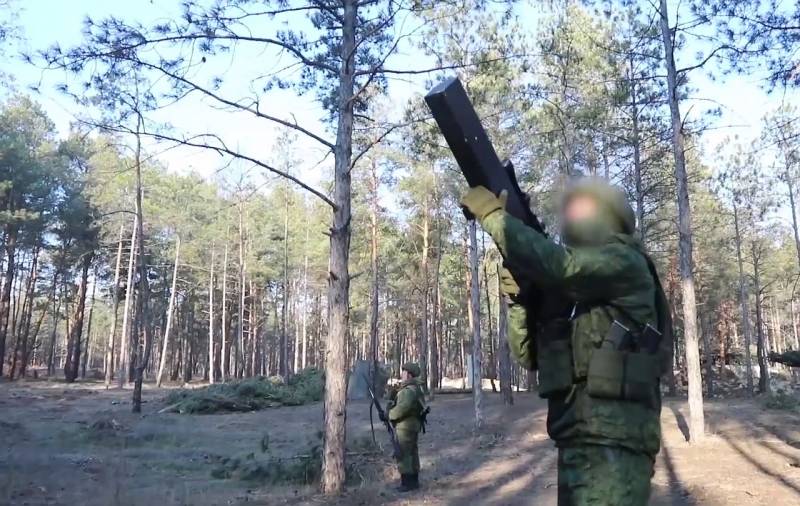
Ukrainian nationalists do not stop trying to strike deep into the territory of Russia, aiming mainly at civilian targets. In military terms, these attacks do not make any sense, but terror has long been a kind of “calling card” of the Kyiv regime.
Today, once again, the Armed Forces of Ukraine made an attempt to strike at the border area in the Belgorod region, Russian telegram channels report. A drone loaded with explosives was used for the attack, presumably launched from the village of Staritsa in the Kharkiv region.
An enemy aircraft of an aircraft type was detected on time by Russian border guards near the village of Murom in the Shebekinsky district, 500 meters from the border with Ukraine this morning. Our military intercepted the control of the UAV with the help of an anti-drone gun and forcibly planted. At the time of the fall, the makeshift warhead detonated. No one was hurt, no damage was recorded. There are no official statements from the local authorities on this incident yet.
Last night, Ukrainian militants using several unmanned aerial vehicles attacked a sugar factory in the border village of Tetkino, Kursk region. At least ten AGS-17 grenade launchers were dropped on the territory of the enterprise. The nearby school and kindergarten were not affected.
The day before, a Ukrainian drone tried to attack a power plant in the village of Dragunskoye near Belgorod.The drone was also timely detected by Russian air defense forces and destroyed on approach. There were no damages or casualties as a result of the incident.
In another region bordering Ukraine, the Bryansk region, the Armed Forces of Ukraine fired mortars at the village of Lomakovka today. A total of twelve strikes were inflicted, some of the mines hit residential buildings and a substation. The villagers lost electricity, according to preliminary data, there are victims among civilians. Currently, residents are hiding in basements, fearing continued shelling.
Yesterday, Ukrainian UAVs attacked the building of the military registration and enlistment office of the Novozybkov urban district of the Bryansk region, the head of the region said on his telegram channel. There were no injuries, the windows were partially broken in the building.
The Governor of the Bryansk region, Alexander Bogomaz, has today introduced a “high alert” regime throughout the entire region, which will be in effect until May 10. The Main Directorate of the Ministry of Emergency Situations of Russia for the Bryansk Region has been recommended to bring forces and assets into readiness to respond to emergencies, form operational groups and, if necessary, organize their deployment to the proposed areas of operations.
spacer
| Mar. 20th or 21 | ~ SPRING EQUINOX (Sabbat Festival, Major Fertility Sabbath) ~ (date varies annually) (Orgy Ritual) Oral, anal, and vaginal; human and/or animal sacrifice |
| March 15 | he Ides of March |
| March 17 | Liberalia – the festival of Liber and Libera, a Roman fertility god and goddess St Patrick’s Day Damballah’s Day Damballah,the primordial snake lwa of life, wealth, and wisdom |
| March 18 | Birthday of Mother Earth – Gudi Padwa Hindu New Year |
| March 19 | SPRING EQUINOX Festival of Anna Perenna – the Roman goddess of the circle of the year. Day of Aganyu St. Joseph’s Day |
spacer
| Oct 13-30 | Preparation for all Hallows Eve, Samhain ( Halloween)
(13 -Backward Halloween Date) |
Abduction, holding and ceremonial preparation of individual for human sacrifice |
| Oct 28-30 Oct 28 – Nov 2 |
Satanist High Holy Day (Holy Day related to Halloween) |
Blood Riturals, human sacrifice each day (any age (male or female) |
| Oct 30-31 | All Hallows Eve and Halloween Night | Blood and Sex rituals. Sexual Climax, association with the demons, animal and/or human sacrifice (any age; male or female) |
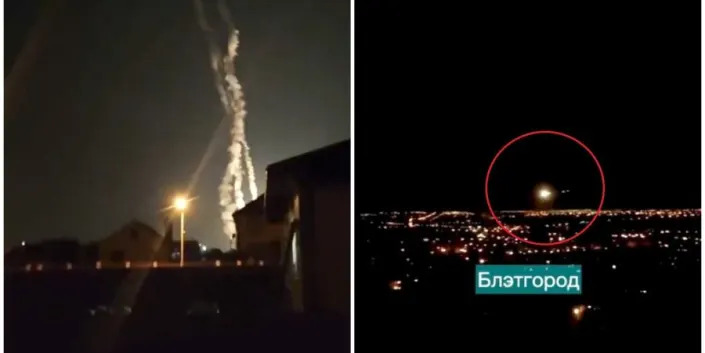
Judging by the footage, the Russian armed forces may have placed a missile launcher within the city limits, putting the local population at risk.
In the video, as the failed missile takes to the sky, exhaust trails from three or four other launches can be seen. The missiles were probably launched at Ukraine
But the missile in the video immediately deviates from its intended upwards trajectory and, flying practically horizontally at low altitude for a few seconds over residential areas, it is seen to explode as it impacts on what appears to be one of the districts of Belgorod.
Read also: Part of Russian anti-aircraft missile found at damaged residential building in Belgorod
Information about possible casualties and destruction has not yet been released, probably because the Kremlin regime considers it better to cover up such incidents.
There have been several other cases of Russian missiles failing on launch that have been captured on video in the last few months.
Read the original article on The New Voice of Ukrainer
| Sep 21 | Midnight Host | blood rituals, dismemberment and hands removed for Hand of Glory | (female) |
| Sept 22, 2022 | Fall Equinox | Sex rituals, Orgies, oral, anal, vaginal | any age |
As Putin’s forces are pushed back to where they came from, there is growing unease in the city of Belgorod
The war has become impossible to ignore in Belgorod, southern Russia, just miles from the border with Ukraine. Russian soldiers retreating from the Ukrainian counterattack now roam the streets. Air defences boom out overhead several times a day. The city is once again filled with refugees. And, at the border, Russian and Ukrainian soldiers stand within sight of each other.
Three Russian soldiers from Ossetia are wandering the unfamiliar streets past the grand Transfiguration Cathedral late one evening. They seem unsteady on their feet, perhaps drunk or tired. And they’re looking for a place to eat.
Since February, they say, they have fought in Ukraine as part of the invasion force. They were stationed in the village of Velyki Prokhody, just north of Kharkiv, when the urgent signal came to flee back to Russia last week.
“What can we say? An order is an order. We didn’t have a choice,” says one wearing a hat emblazoned with a Z, a tactical symbol adopted as a patriotic emblem of war support in Russia.
What does the Z mean on Russian tanks?On many of Russia’s tanks there is a white symbol which looks like the letter Z, sometimes with a white box around it. According to the Russian Ministry of Defence, the “Z” symbol means “for the victory”. However, a military source in the Ukrainian capital Kyiv told The Sun that the Z symbol is most likely to help to avoid friendly fire. The marking prevents Russian forces from attacking their own vehicles but also lets opposing forces identify them. There is a possibility of confusion as Ukrainian tanks look very similar, especially from the air. Other experts claim that the Z symbolises the vehicles are ready to attack. |
 |
 |
As the Russian front in Kharkiv has collapsed and Ukrainians who have chosen the Russian side have fled for the border, a dark thought has crossed the minds of ordinary people here: that the war may cross into Russia.
Asked where they are headed next, the soldiers say they don’t know. But it’s likely, they think, they will be sent back south “to defend the border”.
The following day, some 400 National Guard troops are reinforcing positions held by the Russian border guards. Even there, an activist who was present said, soldiers were soul-searching among themselves. Within eyeshot are Ukrainian troops on the other side in a tense standoff.
“How the fuck did this happen?” one border guard said to another, two people who were there recall.
In Belgorod, the signals of war and tension are on display, even if most people believe the conflict is unlikely to spill over. Oleg, a restaurateur originally from Ukraine wears a shirt emblazoned with the phrase “Born in Kharkiv”, and has bought plywood boards in case he needs to cover his restaurant’s windows.
His business partner, Denis, has built a bomb shelter in his backyard and evacuated his grandmother from a Russian-held town in east Ukraine now on the frontline of the conflict.
Denis says he hopes that tensions will recede. But they are also taking precautions. “Nobody expects it to come here,” says Oleg. “But we have to be ready.”
In Belgorod’s central market, soldiers are stocking up for the winter, signalling that Russia’s war may stretch for the coming months or even longer.
“Where are the balaclavas?” one yells out, rummaging through one of several stalls selling camouflage hats, jackets, thermal underwear and other cold-weather equipment.
“Every day, dozens of the boys come, there are so many of them now [since the counteroffensive],” says Marina, who sells camouflage items in the market. “Everyone has these glum faces. It is more tense now.
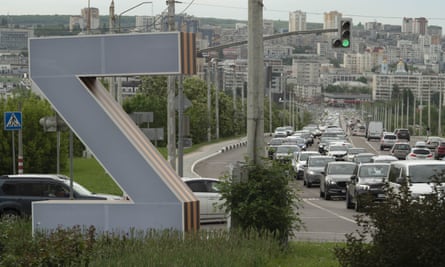
“I see them buying these things, and I wonder why they don’t already have [them],”she also says, adding that the troops are buying basic food and cooking implements that she expected would be supplied by the army.
An elderly woman in the market cries on one of their shoulders. “Please, please help us,” she sobs emotionally. Men walk up to clap the soldiers on the back. Overhead, an explosion is audible.“Air defences,” one man murmurs.
“You feel [the war] here in a way you don’t feel it in other cities,” says Andrei Borzikh, a bankruptcy lawyer who has been crowdfunding thermal rifle scopes and other equipment for the Russian army. He carries a helmet and a bulletproof vest in his car. “You hear it.”
Ukraine has not given any indication that it intends to cross the border or do more than retake territory occupied by Russia. But the very idea of the Kremlin’s quick, victorious war boomeranging back across the border into Russia speaks to the realities of the defeat suffered by its forces in recent days.
“Some miscalculations were made in any case – maybe they were tactical, maybe they were strategic,” says Borzikh. “The fact that Russia thought it had come there for ever was clear.”
Like other boosters of the Russian army, he says that the recent defeats should be attributed to western support for Ukraine. “Russia is now in a conflict with a third of the world community,” he says.
The governor of Belgorod region, Vyacheslav Gladkov, reissued an order on Monday requiring local authorities to check their bomb shelters. Schools near the border have been temporarily closed. Online videos show volunteers cutting down trees to build fortifications in the forested areas south of the city.
People here now understand that the war is not going well. In a series of interviews, locals describe feeling shock in the early days of the war, followed by a rise in patriotic sentiment accompanied by pro-war symbols such as the popular Z plastered on cars and buildings.
Asked about direct consequences of the war for people in Belgorod, he points to the arrival of refugees and a recent blackout caused by an explosion hitting a nearby power station.
Soldiers had also been growing rowdy at the karaoke cafe where he works behind the bar. Fights break out regularly, he says. One group of soldiers refused to pay their bill and then pulled a pistol on a bouncer.
But largely, he says, apathy reigns in Belgorod.“For us, it feels like no one cares until it touches them personally. Until someone brings a coffin to your home, nobody cares.”
Some families are split by the border. Irina, a travel agent, lives with her daughter in their native Belgorod. But her ex-husband and father of her child lives in Kharkiv.
spacer spacer
War May Be Distant in Moscow, but in One Russian Border City, It’s Real

BELGOROD, Russia — Military trucks and armored personnel carriers spray-painted with the letter Z rumble through intersections, and groups of men in camouflage walk the streets and shop for military goods like thermal underwear. Refugees pour in from territories in Ukraine that were recently lost to the enemy.
The sound of nearby explosions have become regular occurrences in Belgorod, and anxious store owners call the police reporting imagined bomb threats, a sign of the paranoia that is starting to spread. Residents express fear about what will come next, with some even speculating that Ukrainian troops could take a step they have avoided for nearly seven months and enter Russian territory.
“It is as if they are already here,” an ashen-faced woman told a merchant at the city’s central market, after the boom of an explosion.
President Vladimir V. Putin has tried to keep life as normal as possible for most Russians as he conducts his war in Ukraine, and to make the hostilities a distant concept. But with Ukrainian forces now on the offensive, residents of Belgorod, 25 miles from the Ukrainian border, feel like the war has come to their doorstep.
“There are so many rumors, people are afraid,” said Maksim, 21, a merchant at the market.
He was selling thermal underwear, camouflage jackets and other sporting goods that once went to hunters and fishermen but are now being bought up by soldiers and their relatives. Like most other residents interviewed for this article, he declined to provide his full name out of fear of retribution.
The mood at the market, a warren of stalls selling clothes, home goods and military gear, was tense. Though the city of Belgorod is not being directly attacked, Russia’s military air defense is intercepting missiles in the distance. The sounds of the explosions ring out, and in the Komsomolsky neighborhood, homes and property are being hit by debris.
“We feel scared, and it is especially hard when you work with children,” said Ekaterina, 21, a kindergarten teacher who said a shell fragment fell onto the school early this week. “The children start running around screaming ‘missiles’ but we tell them it is just thunder.”
While most residents of Belgorod support the government and the war effort, some express frustration that the rest of the country is still living as if it isn’t waging a full-scale war.
“How are they not ashamed!” shouted a middle-aged woman named Lyudmila, from the Komsomosky neighborhood.
“In Moscow, they are celebrating City Day, while here blood is being spilled,” she said, referring to a citywide celebration honoring the founding of the capital, which featured fireworks and the grand opening of a large Ferris wheel by Mr. Putin. “Here everyone is worried about our soldiers, while there everyone is partying and drinking!”
Even those who support the war effort privately expressed frustration that the Kremlin insists on calling it a “special military operation,” when they can see that it is a full-blown war. Many wonder if there will be a draft, and if so, how soon.
Refugees arriving from Ukraine are also driving home the reality of the war.
Mr. Ksenov, who was born in Kharkiv but made Belgorod his home more than a decade ago, has dedicated his time to helping civilians flee from Ukraine to Russia. He worries about what will happen to the people from border regions of both countries in the long term.
“This slaughter will eventually end,” he said of the war, in an interview in his restaurant, which has plywood covering the windows in case of a bombing.
“But who will we be? How will we look one another in the eyes?”
The post War May Be Distant in Moscow, but in One Russian Border City, It’s Real appeared first on New York Times.
| Sep 7 | Marriage to the Beast | sacrifice, dismemberment, sexual rituals | infant – 21 (female) |
Sep 1, 2022 Videos circulating online appear to show the moment a Russian missile launch went spectacularly wrong.
Ukrainian military officials said that on Wednesday night, the Russian army launched six S-300 air defense missiles in the direction of Kharkiv in northeast Ukraine, however, one of the missiles deviated off-course, and hit a district in the Russian city of Belgorod, near the Ukrainian border.
Several Belgorod residents caught the moment on camera, Ukrainian military officials said.
Video shows Russian missile malfunction, hit own territory in Belgorod
Sep 1, 2022
spacer
| Jul 1 | Demons Revel | blood rituals, Druid sexual association with demons any age (female) |
| July 4 | Independance Day
MidSummer’s Eve |
The focus of the festival is fire, used to bring the life-giving power of the sun god down to earth. There were huge bonfires on every hilltop. Circle rituals, feasting and drinking. Modern Fireworks |
spacer
Part of Russian anti-aircraft missile found at damaged residential building in Belgorod
3 July 2022, 05:37 PM
This information was confirmed by Oleg Zhdanov, popular Ukrainian military analyst, and Conflict Intelligence Team, a group of Russian bloggers who cover Russia’s war against Ukraine using open-source investigation techniques.
A photo of part of the missile – the booster stage – that hit a multi-story building in Belgorod was published by Zhest Belgorod, a Russian Telegram channel.
Vyacheslav Gladkov, the governor of Belgorod Oblast, on July 3 said the city had been hit by three Ukrainian “self-guiding missiles of the Tochka-U type.” According to Gladkov, the local air defense system intercepted the Ukrainian missiles, but one of them fell on a residential block.
He provided no evidence to support his claim.
Four people died, Gladkov said, and four received injuries. The damaged building had 21 apartments, while 40 smaller private houses were hit by a blast wave. Earlier, Gladkov reported a “series of bangs” in Belgorod.
Meanwhile, Ukrainian President Volodymyr Zelenskyy has said Ukraine is not planning to hit Russian territory with any weapons, is not going to invade it, and only uses its weapons to liberate its own sovereign territory.
Ukraine blamed by Russia for deadly blast in border city of Belgorod
-
Published
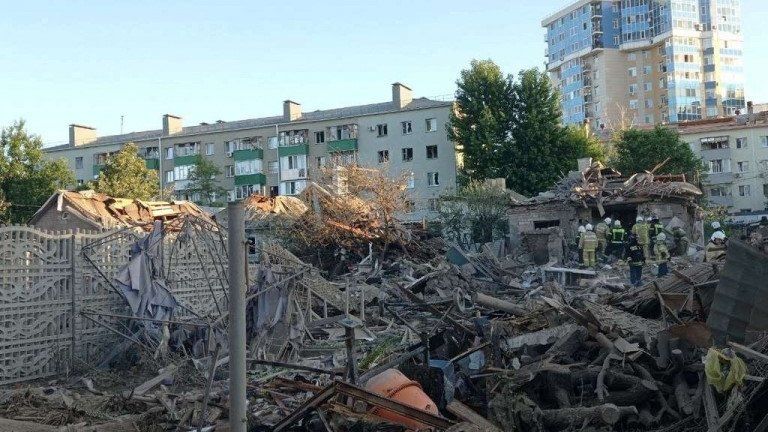
The regional governor said the blasts hit dozens of residential buildings and air defences had been activated.
The Kremlin said that Sunday’s attack had been a deliberate attempt by Ukrainian forces to target civilians.
Ukraine dismissed the claim, saying the Russians had lied about similar incidents in the past.
Belgorod – a city of 370,000 that lies just north of Ukraine’s second city, Kharkiv – has been attacked on several occasions since Moscow invaded Ukraine in February.
The latest incident happened in the early hours of Sunday morning.
Russian defence ministry spokesman Igor Konashenkov said air defences had destroyed three Ukrainian Tochka-U ballistic missiles with cluster warheads, but fragments of one of them fell on a block of flats.
“This missile attack was intentionally planned and launched at the civilian population,” he added.
Ukrainian defence ministry spokesman Yuriy Sak told the BBC that previously “our security service has many times intercepted phone calls between the Russian servicemen which prove that sometimes, most often, these types of activities are… provocations by the Russian side themselves”.
Another Ukrainian official, Serhiy Bratchuk, said rocket debris embedded in a damaged Belgorod apartment block came from a Russian Pantsir anti-aircraft system, which Ukraine does not have.
In early April, Russia said two Ukrainian helicopters had attacked a civilian oil storage depot on the outskirts of Belgorod, causing a fuel blaze.
Video appeared to show missiles hitting the facility. The Ukrainian military denied that it was involved.

Since Russia invaded on 24 February, claiming it wanted to “demilitarise” and “de-Nazify” Ukraine after it moved closer to Nato, thousands of civilians and combatants have been killed or wounded, while at least 12 million people have fled their homes.
Western states have responded by arming Ukraine and placing unprecedented sanctions on Russia, a nuclear superpower and global energy supplier.
spacer
| March 31 | Festival of Luna – Goddess of the Moon |
| April 1 | April Fool’s Day Loki’s Day The Veneralia – the festival of Venus, the Roman goddess of love and beauty |
| April 2 | Ramanavami – Fasting and Chanting |

Russia accused Ukraine of mounting a helicopter attack on a fuel depot inside Russian territory Friday, as footage surfaced of the facility engulfed in flames.
In a statement, Russia’s Ministry of Defense said that the helicopters “entered the airspace of the Russian Federation at extremely low altitude,” at 5 a.m. Moscow time and “launched a missile attack on a civilian oil storage facility located on the outskirts of Belgorod.”
As a result, “individual tanks were damaged and caught fire,” spokesperson Maj. Gen. Igor Konashenkov said, adding that the depot “has nothing to do with Russian armed forces.”
CNN could not verify the Russian claims.
The Ukrainian Ministry of Defense has neither confirmed nor denied the attack. Russia has hit fuel storage facilities around Ukraine in recent days.
“I would like to emphasize that Ukraine is performing a defensive operation against Russian aggression on the territory of Ukraine,” Oleksandr Motuzyanyk, spokesman for Ukraine’s defense ministry, said in a televised statement Friday.
“That doesn’t mean Ukraine has to be responsible for every miscalculation or event or catastrophe that occurred on the territory of the Russian Federation. This is not the first time we are witnessing such accusations. Therefore, I will neither confirm nor deny this information.”
CNN geolocated and verified social media videos showing two helicopters flying over the Russian city of Belgorod, near the Ukrainian border, but cannot confirm the helicopters are Ukrainian.
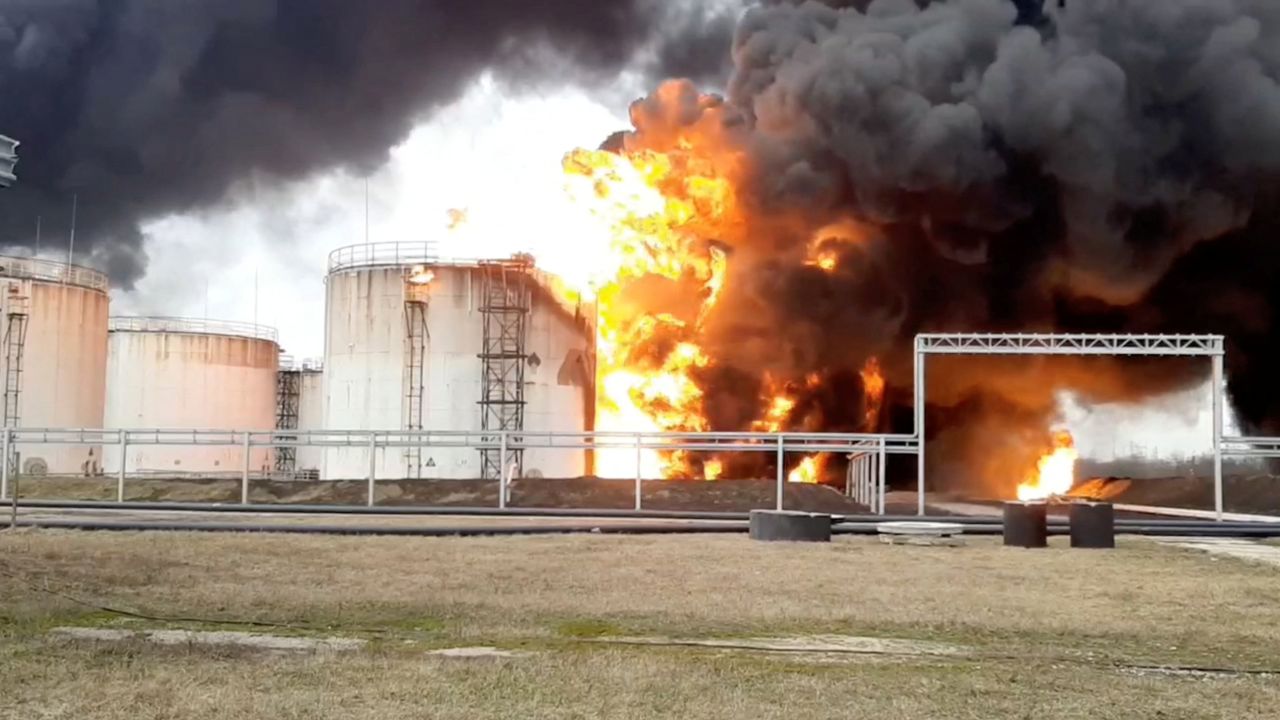
In one video, they are spotted during an attack on a fuel storage facility. The video, which was shot at a distance of about 1,800 feet (550 meters) from the facility, shows multiple strikes and a subsequent fire in the distance.
The Belgorod region – which is on the road from Moscow to Ukraine’s second largest city, Kharkiv – has been a hub of fuel supplies that have powered Russia’s invasion of of Ukraine.
The ensuing fire “engulfed fuel reservoirs” at the facility, Russian state media outlet TASS reported, citing the ministry of emergency situations.
About 16,000 cubic meters (3.52 million gallons) of fuel were on fire, encompassing eight tanks with 2,000 cubic meters of fuel each, Russian state media outlet Ria Novosti reported, citing emergency services, and there was the possibility that the fire could spread to another eight tanks.
“The president was informed about Belgorod,” Peskov said in a conference call with reporters. “You know that the ministry of emergency situations was sent there. Steps are being taken to reorganize fuel supply points so that what happened in no case affects the level of supply of all necessary types of fuel.”
The Russian military has claimed air superiority over Ukraine.
“Air superiority during an operation is an absolute fact,” Peskov said. “And as for what happened, it probably should not be us giving out assessments, but our law enforcement agencies.”
CNN’s Gianluca Mezzofiore, Katie Polglase and Celine Alkhaldi contributed to this report.
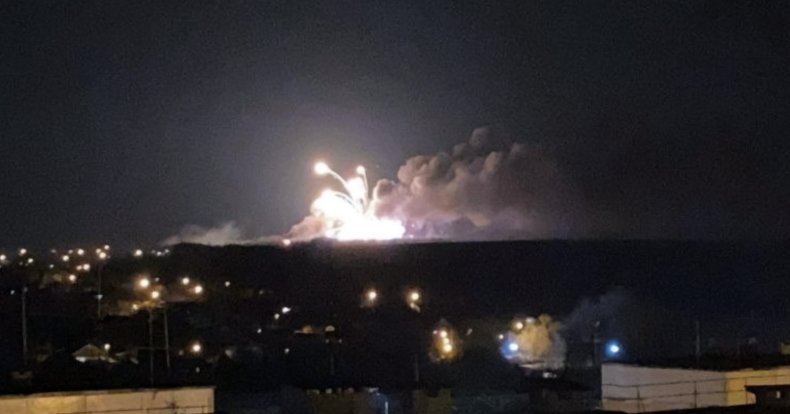
A number of images and videos of an explosion allegedly in the Russian military town near Belgorod spread on social media Tuesday, March 29. TWITTER/@NOTWOOFERS
OSINTdefender on Twitter: “It’s now seems there may have been 2 …

History of Belgorod
Origins
There is evidence of human settlement in the area of modern-day Belgorod since the 10th Century. This precursor to modern Belgorod bore the same name which means White City in Russian (bely meaning white and gorod meaning city), due to the area being rich in limestone. The original Belgorod was destroyed in 1237 during the Mongol-Tatar Invasion of Rus. Only several centuries later would Belgorod be re-founded.
16th and 17th Century
In 1596 Tsar Feodor I, acting on the orders of his regent Boris Godunov, ordered Belgorod be re-founded as a fortification and the new settlement was made the centre of the Belgorod Division – a military and administrative region. During this time Moscow was concentrating on securing its south-western borders from Crimean Tatar and Nogai raids. In the early 17th century Belgorod was an important fortress on the Belgorod Abatis Border, part of the Great Abatis Border, which was a fortification barrier stretching hundreds of kilometres made by building barricades from felled trees and by digging ditches and making mounds.
18th Century
St Joseph (Ioasaf) of Belgorod
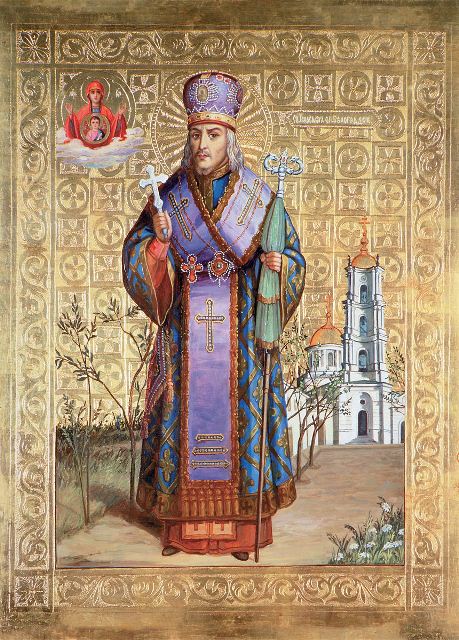
Saint Joasaph of Belgorod / OrthoChristian.Com
In 1748 Archimandrite Ioasaf of the Troitse-Sergieva Lavra was ordained Bishop of Belgorod and Oboyan. During his term as bishop he became known for visiting and helping the eparchy’s poor and sick. Ioasaf died in 1754. His body was eventually interned in Belgorod’s Holy-Trinity Cathedral and several years later was discovered to be incorrupt. News of this spread around the empire and pilgrims started to visit Ioasaf’s relics which were credited as miracle-working. Finally at the request of Emperor Nicholas II, Ioasaf was canonised in 1911 as St Joseph (Ioasaf) of Belgorod.
Spacer
Loss of Defensive Significance
In 1727 Belgorod became the administrative centre of the Belgorod Governorate of the Russian Empire. The city’s strategic importance diminished with Russia’s gradual incorporation of Ukraine in the 17th and 18th centuries. Its defensive significance was then virtually completely lost when the Crimean Khanate was eventually defeated by Russia in 1783. Its loss of significance was clearly demonstrated when its status was decreased to that of a district centre within the Kursk Governorate in 1779.
 19th Century
19th Century
Industrial Development
Old photograph of Belgorod
Throughout the 19th century, Belgorod saw a growth in its industrial output. Its principal industries were the production of chalk, wool and wax. The city also became known for producing lard (salo) and the alcoholic drink called gorilka (similar to vodka). According to the Brockhaus and Efron Encyclopedic Dictionary, which was published in Russia at the end of the 19th century, Belgorod had 15 churches, two cathedrals, a monastery and a convent, various educational institutes and 41 factories.
20th Century
Soviet Period
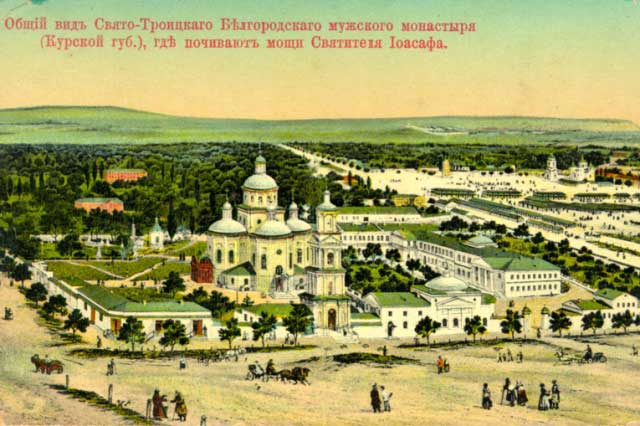 Postcard depicting the internment of the relics of St Joseph in Belgorod
Postcard depicting the internment of the relics of St Joseph in Belgorod
Soviet power was established in Belgorod in October 1917, but the city fell to German troops in April 1918. After the Treaty of Brest-Litovsk, Belgorod found itself in the zone of German Occupation. Eventually Belgorod became part of the Ukrainian State of 1918, until its Hetman Pavlo Skoropadsky was overthrown and the Red Army recaptured Belgorod. Once the Soviets had secured the city for themselves they began shutting down the city’s monasteries and churches. In 1925 the Svyato-Troitsky Monastery and its Trinity Eparchial Cathedral were closed down and later demolished.
Second World War
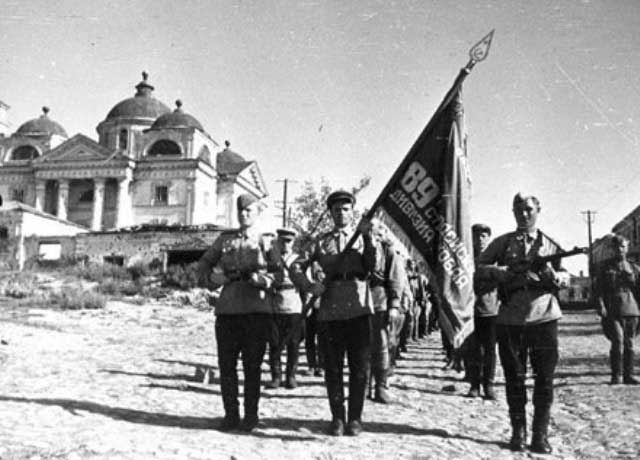 Red Army liberators in Belgorod (1943)
Red Army liberators in Belgorod (1943)
Belgorod was once again occupied by Germany during the Second World War. There were two periods of Nazi occupation during the war: from 24 October 1941 to 9 February 1943 and from 18 March to 5 August 1943. The city was almost completely destroyed during these periods. Upon Belgorod’s final liberation on 5 August 1943, fireworks were set off in Moscow for the first time during the war. As a result, along with the city of Oryol, Belgorod was named “City of the First Fireworks”and 5 August became City Day in Belgorod. The Belgorod-Kharkov Offensive, including the largest tank battle in history which took place in nearby Prokhorovka, was an important part of the larger Battle of the Kursk Salient and the city was recently awarded the status of City of Military Glory for its bravery, resistance and heroism. After the war the city became the centre of the newly-established Belgorod Region and the rebuilding process began.

Historical Bas-relief in Belgorod the Obelisk of Military Glory …
 |
Battle of Belgorod – July 1943 – YouTube |
Rus (name) – Etymology
Etymology
Further information: Rus people According to the most prominent theory, the name Rus, like the Finnish name for Sweden (Ruotsi), is derived from an Old Norse term for “the men who row” (rods-) as rowing was the main method of navigating the rivers of Eastern Europe, and that it could be linked to the Swedish coastal area of Roslagen (the Rowing crews) or Roden, as it was known in earlier times. The name Rus would then have the same origin as the Finnish and Estonian names for Sweden: Ruotsi and Rootsi.
The Danish scholar T.E. Karsten has pointed out that the territory of present-day Uppland, Södermanland and East Gotland in ancient times was known as Roðer or roðin. Thomsen accordingly has suggested that Roðer probably derived from roðsmenn or roðskarlar, meaning seafarers or rowers. Ivar Aasen, the Norwegian philologist & lexicographer, noted Norwegian dialect variants Rossfolk, Rosskar, Rossmann.
Rus (name)
Originally, the name Rus (Русь, Rus’) referred to the people, the region, and the medieval states (9th to 12th centuries) of the Rus’ Khaganate and Ruthenia (Kievan Rus) polities. In the western cultures and English language the term is better known as Ruthenia since 11th century. Its territories are today distributed among Belarus, Ukraine, and a part of the European section of Russian Federation.
One of the earliest written sources mentioning the people called Rus (as Rhos) dates back to year 839 AD in a Royal Frankish chronicle Annales Bertiniani; the Frankish authorities identified them as a Germanic tribe called Swedes. According to the Kievan Rus Primary Chronicle, compiled in about 1113 AD, the Rus were a group of Varangians, Norsemen who had relocated somewhere from the Baltic region (literally “from beyond the sea”), first to Northeastern Europe, then to the south where they created the medieval Kievan state.
The modern name of Russia (Rossiya), which came into use in the 17th century, is derived from the Greek Ρωσσία (nowadays spelled Ρωσία) which in turn derives from Ρως, an early Greek name for the people of Rus’. “Rus’” as a state had no proper name; by its inhabitants it was called “rusĭska zemlya”.(русьска(я) земля) (with rusĭska alternatively spelled russka, rus’ka, and most often ruska), which might be translated as “Land of the Rus”. The word “rusĭska” is an adjective: the morpheme -ĭsk- is used to form adjectives in Slavic; -a is a grammatical ending for feminine adjectives (namely, zemlya, “land”, is grammatically feminine in Slavic). In similar fashion, Poland is called Polska by its inhabitants, that is, Pol-sk-a, originally being the adjective Polish (land).
To distinguish the medieval “Rus” state from other states that derived from it, modern historiography calls it “Kievan Rus’.” Its predecessor, the 9th-century “Rus’ Khaganate,” is a somewhat hypothetical state whose existence is inferred from a handful of early medieval Byzantine and Persian/Arabic sources that mention that the Rus’ people were governed by a khagan.
spacer
Belgorod – Break down of the name
spacer
spacer
Białogard
|
Alba – Etymology – LiquiSearch |
|
regia – Wiktionary |
As Belgard, with all of Farther Pomerania, the town became part of Brandenburg in 1653[6] and became part of the Kingdom of Prussiain 1701. In 1724 Belgard was made the capital of a county in the Province of Pomerania, and after the administrative reorganization in 1815, the capital of Landkreis Belgard (Belgard county).
The first post office in Belgard was opened in 1825. In 1858 the first railroad connecting Belgard to Köslin (Koszalin) and Schivelbein (Świdwin) was completed; it was extended to Stargard and Neustettin (Szczecinek) in 1878. Belgard became part of the German Empire in 1871.
Białogard was made a county city in the Szczecin Voivodeship, was later assigned to the Koszalin Voivodeship, and is now located in the West Pomeranian Voivodeship. In 1999 the 700th anniversary of receiving town rights was celebrated with the participation of Polish President Aleksander Kwaśniewski, who was born in Białogard
spacer
-
Belshazzar
BELSHAZZAR Meaning: “Bel-protect-the-king” (see Bel). See origin and meaning of belshazzar. Bel as in BAAL.
For more information on the root word Bel see the following posts:
spacer
spacerspacer
|
Gord (archaeology) – Wikipedia |
Bely Gorod
Bely Gorod(highlighted in yellow) on Matthäus Merian‘s map of Moscow
Bely Gorod (Russian: Бе́лый го́род, IPA: [ˈbʲelɨj ˈɡorət], “White City”) is the central core area of Moscow, Russia beyond the Kremlin and Kitay-gorod.
The name comes from the color of its defensive wall, which was erected in 1585–1593 at the behest of tsar Feodor I and Boris Godunov by architect Fyodor Kon’. The wall is 10 kilometers (6.2 mi) in length, and its width ranges up to 4.5 meters (15 ft) at its widest.
Bely Gorod had 28 towers and 11 gates, the names of some of which are still preserved in the names of squares, namely: Trehsvyatsky, Chertolsky (Prechistensky), Arbatsky, Nikitsky, Tversky, Petrovsky, Sretensky, Myasnitsky, Pokrovsky, Yauzskiy, Vasilievsky. The walls were cogged, like the Kremlin walls, with loopholes that allowed keeping a continuous fire.
During the reign of Catherine the Great and her grandson Alexander I the wall was demolished and replaced by a chain of boulevards, known as the Boulevard Ring.
|
boulevard | Etymology, origin and meaning of boulevard by etymonline |
spacer
Ancient and modern mixes in award winning Moscow square
Khokhlovskaya Square as a “Moscow Agora” has become a new urban centre which attracts both the local community as well as tourists, and has also given a boost to local businesses.
As part of a wider regeneration project for the historical Pokrovskiy Boulevard Ring, the new square, which opened to the public in September 2017, is in fact an archaeological preservation of the remains of the Belgorodskaya (or White) Wall.
|
Belgorodskaya
What Does The Name Skaya Mean? – The Meaning of Names According to 4 people from all over the world, the name Skaya is of German origin and means “The wolf”. A submission from the United Kingdom says the name Skaya means “Skara means wolf and German” and is of Arabic origin. A submission from California, U.S. says the name Skaya means “Russian suffix ‘belonging to'” and is of Russian origin.
|
|
boulevard (n.) |
spacer

Khokhlovskaya Square by night. Photo credit – Olga Alexeyenko.
After a fragment of the ancient stone wall, almost five centuries old, was unearthed by archaeologists around ten years ago, excavation of the site was halted as moving the wall without damaging it would have been impossible.
Instead Strelka KB together with Djao-Rakitine have created a 3,853 m2 square which consists of a curved amphitheatre that responds to the existing level change on site. It connects the historical wall on the lower level to the level of the street, and the amphitheatre steps become a place for the public to sit and meet, as well as allowing maximum visibility of the White Wall, and providing a natural stage for small concerts and events.
 |
 |
| Djao-Rakitine have created a 3,853 m2 square surrounded by a curved amphitheatre. | Fragments of the Belgorodskaya Wall were unearthed by chance. |
The upper tier is on the same level as Pokrovsky Boulevard, and features a wide promenade area, cafes, terraces, benches, and low-energy street lamps for the evenings.
|
покров ( pokróv ) – Wiktionary |
|
Pokrov-spiritually religious movement |
|
Eastern Slavic naming customs – Wikipedia |
|
THE FEAST OF POKROV, ITS BYZANTINE ORIGIN, AND THE CULT OF … – Brill |
|
Protection of the Mother of God – OrthodoxWiki |
|
The icon of Pokrov: Ukraine’s favorite Madonna
Monastère orthodoxe Marzena Devoud – published on 04/09/22 Ukraine’s national holiday — celebrated October 14 — is the feast day of the Pokrov icon. It commemorates an appearance of the Virgin Mary in Constantinople. To understand the love of Ukrainians for the Madonna of Pokrov, we must go back to the 10th century. At that time, whenever the Byzantine Empire (recall that its capital city was Constantinople) was threatened by the Arabs or Slavs, the Virgin Mary appeared with St. John the Baptist and St. John.
The Virgin Mary and these two saints appeared to St. Andrew, called Andrew the “Fool in Christ,” in the Church of the Blacherns in Constantinople. This church is an illustrious Marian shrine and a very beautiful church in the city. During the apparition, the Blessed Mother went in tears to the altar, placing her own veil that covered her head over the people to protect and save them. “Pokrov” means “the veil” in the literal sense and borrows, from the Hebrew of the Old Testament, seter (veil), the figurative sense of “protection” or “security.” The feast of the Pokrov icon therefore means, in other words, Our Lady of Protection. This feast, which commemorates her appearance, has been proclaimed the national holiday of Ukraine. It is celebrated on October 14. During the time of the Soviet and Nazi occupation, this icon took on immense importance for the Ukrainian nation, which reveres it as one of its favorite icons. Interestingly, this festival was established in Russia in the 12th century during the reign of Vladimir Prince Andrew Bogolioubsky (1157-1174), whose patron saint was St. Andrew. Outside Russia, it is celebrated in Ukraine, but also in Bulgaria, Romania and also in Greece. A veil of protectionThe icon of Pokrov represents the Mother of God standing in orans (praying position) with her arms raised, in a Byzantine church decor, and accompanied by the saints. Two variations exist: either the Virgin herself spreads her veil widely, or two angels spread the veil over the people. Above the extended veil stands the bust of Christ. Pokrov’s prayer to the Virgin alludes to her veil shining over the saved crowd:
|
A black concrete wall covered in climbing ivy serves as a backdrop to the White Wall, and other planting includes leafy lime trees. The monument is lit by floodlights at night.
While the fragments of the Belgorodskaya Wall were unearthed quite by chance, Strelka KB and Djao-Rakitine have capitalised on this rare find and created a square which has become a historical must-see for Muscovites and visitors alike.
spacer
<
White is the blending of all colors and is a color.
Explanation:
Light appears colorless or white. Sunlight is white light that is composed of all the colors of the spectrum. A rainbow is proof. You can’t see the colors of sunlight except when atmospheric conditions bend the light rays and create a rainbow. You can also use a prism to demonstrate this.
Fact: The sum of all the colors of light add up to white. This is additive color theory.
White is not a color.
… but …. in some cases you could say that white is a color.
The grey area:
Technically, pure white is the absence of color. In other words, you can’t mix colors to create white. Therefore, white is the absence of color in the strictest sense of the definition.
However, when you examine the pigment chemistry of white, ground-up substances (such as chalk and bone) or chemicals (such as titanium and zinc) are used to create the many nuances of white in paint, chalk, crayons – and even products such as Noxema. It’s worth noting that white paper is made by bleaching tree bark (paper pulp). Therefore, you could say that white is a color in the context of pigment chemistry.
spacer
spacer
spacer
Limestone also has considerable commercial importance. Limestones enriched in phosphateby the chemical action of ocean waters constitute a principal source of raw materials for the fertilizer industry.
spacer
Remember that this city was rebuilt in modern times. Very few ancient buildings, or even old buildings exist here. It is a modern version of Belgorod. I wonder, was there something that the forces of evil did not want us to see?Though we are told that Belgorod means WHITE CITY… We have seen from the above that BEL- is the name of the Head Pagan God known as BAAL. And Gorod can be interpreted as fortress or stronghold. Which you will see in this next article definitely applies. So the NAME BELGOROD mean BEL’s STRONGHOLD or STRONGHOLD OF BAAL!!
acer
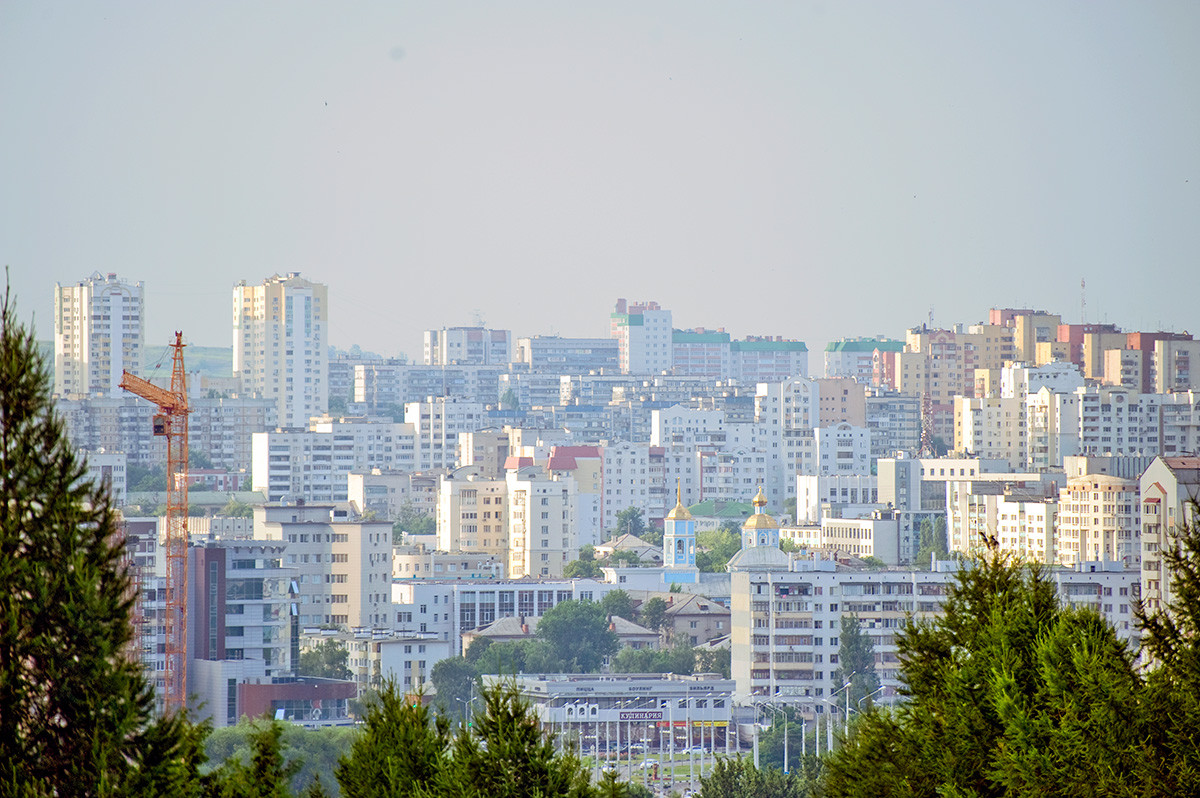
Belgorod panorama. View north from August 5th Street (named in honor of city’s final liberation from German occupation on August 5, 1943). June 24, 2015
William Brumfield
The town of Belgorod (“white town”) near Russia’s western border gets its name from the nearby white chalk hills, part of a distinctive geological feature of Campanian age formations in southwestern Russia. The city (current population 394,000) is situated on the River Vezyolka near its confluence with the Seversky Donets, which flows south into Ukraine, past Donetsk, before reentering Russia near Rostov-on-Don. The border is only 40 km to the southwest, thus making Belgorod the closest major Russian city to Ukraine.
In early September 1911, Russian chemist and photographer Sergey Prokudin-Gorsky visited Belgorod to document the celebration of the canonization of a local bishop. My own visit in June 2015 reveals a Belgorod much altered by 20th-century cataclysms.

Church of the Intercession of the Virgin, Mary-Martha Convent. South view. June 24, 2015
William Brumfield
Protector of the borderlands
Belgorod is generally considered to have been founded in 1593 (or 1596) during the reign of Tsar Feodor (1557-98), son of Ivan the Terrible and last ruler in the Riurikovich dynasty. With the advice of Boris Godunov, Feodor developed a series of fortified settlements intended to protect Muscovy’s southern borderlands. The Belgorod fortress became the anchor in what was known in the 17th century as the Belgorod Line, an important bulwark against incursions by Crimean Tatars.
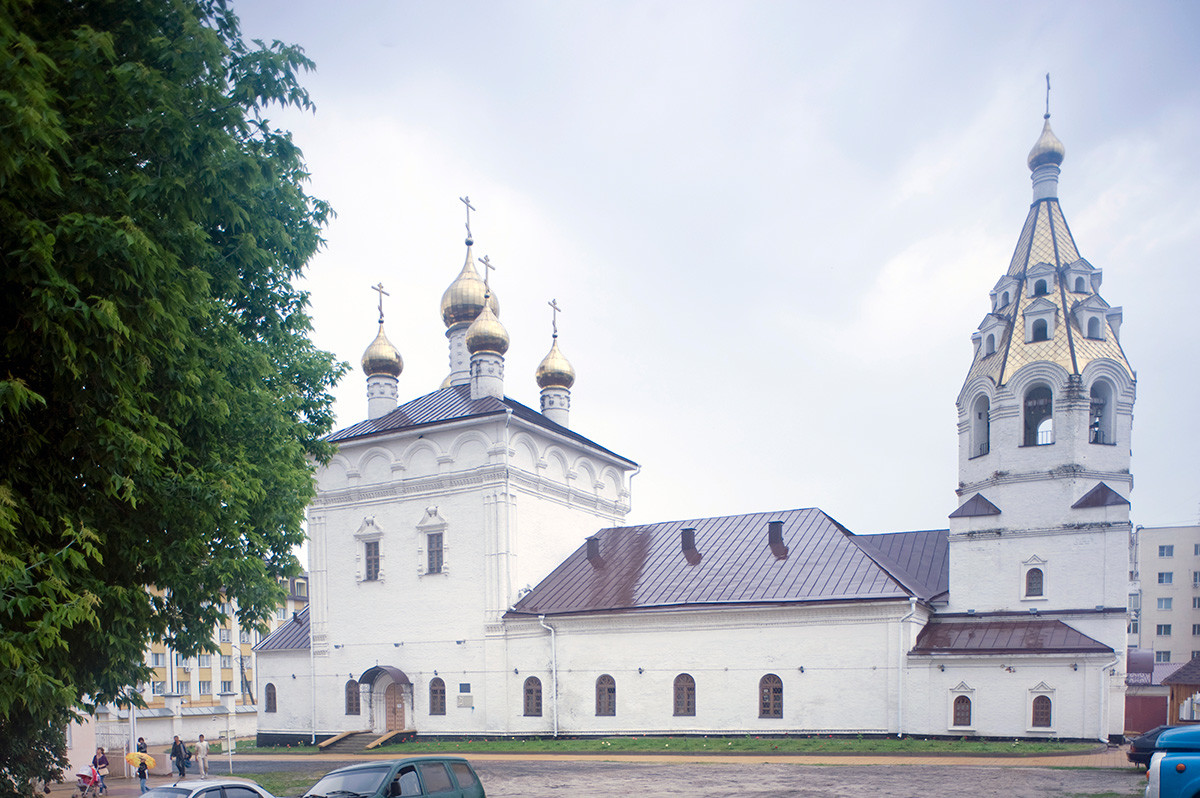
Cathedral of the Dormition & St. Nicholas, Mary-Martha Convent. North view. June 24, 2015
William Brumfield
In 1612,the fortress established by Tsar Feodor was seized and burned by Polish forces during a dynastic crisis known as the Time of Troubles. Rebuilt at a slightly different location, the fortress was frequently attacked in the first half of the 17th century.
With the absorption of Ukrainian lands (the Hetmanate) into the Muscovite state in the latter part of the 17th century, the military significance of Belgorod decreased. In the 18th century it became a modest provincial administrative and trading center.
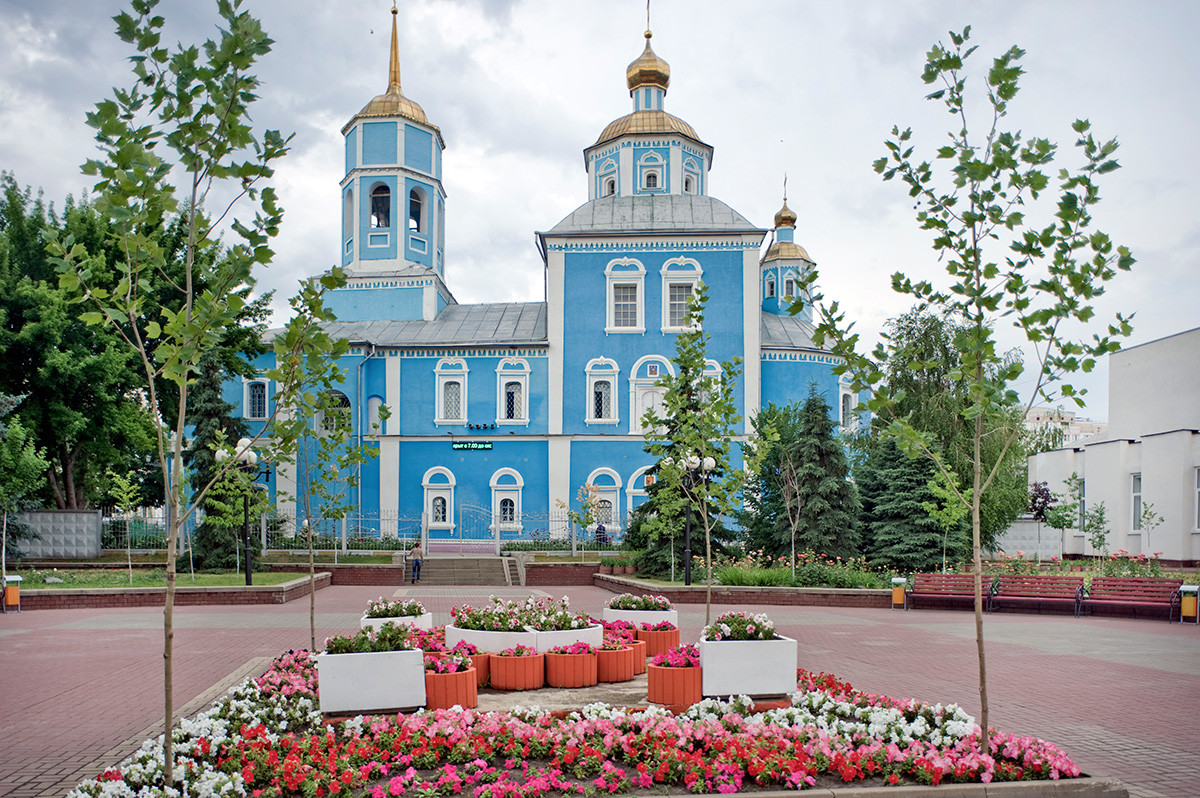
Cathedral of the Smolensk Icon of the Virgin. South view. June 24, 2015
William Brumfield
City of churches
Belgorod’s earliest surviving church is the Cathedral of the Dormition and St. Nicholas at the Mary-Martha Convent. Begun in the 1690s and completed in 1703, the cathedral’s construction benefited in 1701 from the donation of 100 rubles by Tsar Peter I (the Great).
|
Dormition of the Mother of God – Wikipedia |
|
Dormition Definition & Meaning – Merriam-Webster |
spacer
____________________________________________________________________________________
Cathedral of the Transfiguration, northwest view.
June 24, 2015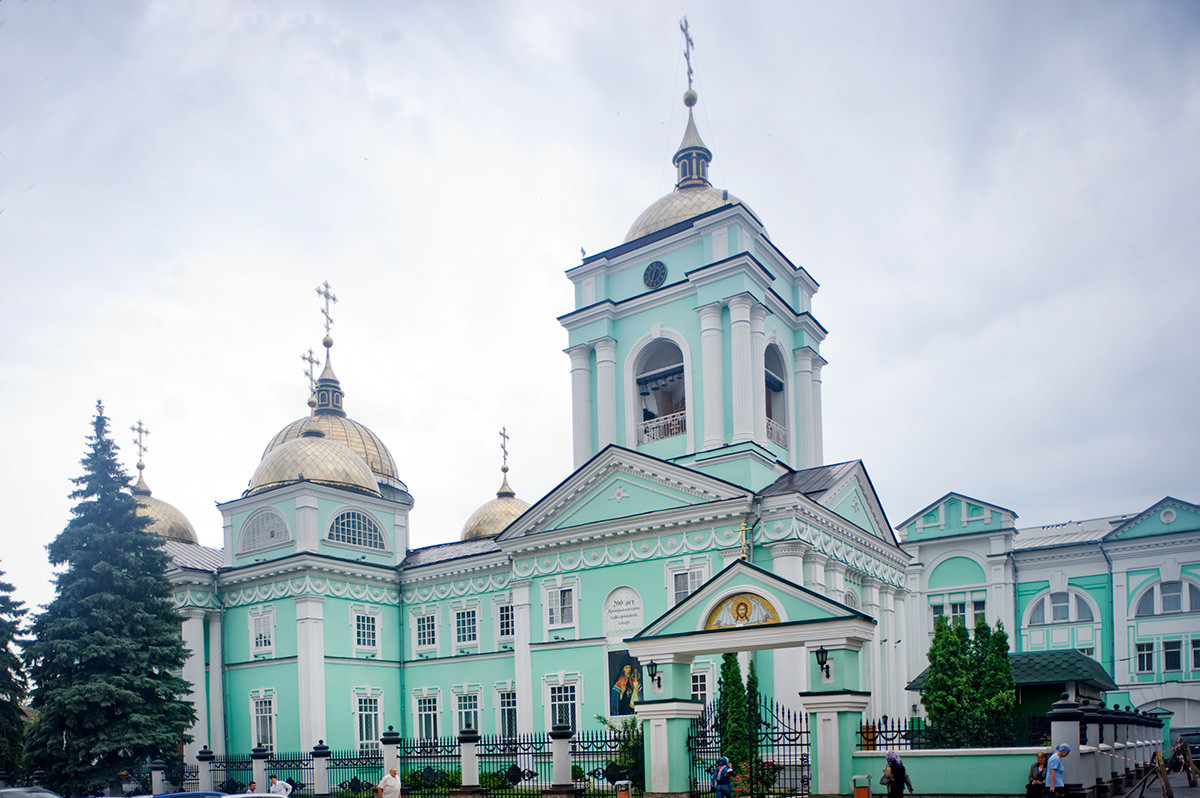
William Brumfield
Severely damaged during the Soviet period, the cathedral was returned to the Orthodox Church in the 1990s and now has a new icon screen by the artist Alexander Rabotnov. The convent’s other major church, built in 1791, is dedicated to the Intercession of the Virgin.
Also dating from the 18th century is the Cathedral of the Smolensk Icon of the Virgin, consecrated in two phases with altars on the upper and lower levels. Two attempts were made to demolish the solid structure (in 1958 and 1974), but the explosives only damaged neighboring buildings. The cathedral was reconsecrated in 1996.
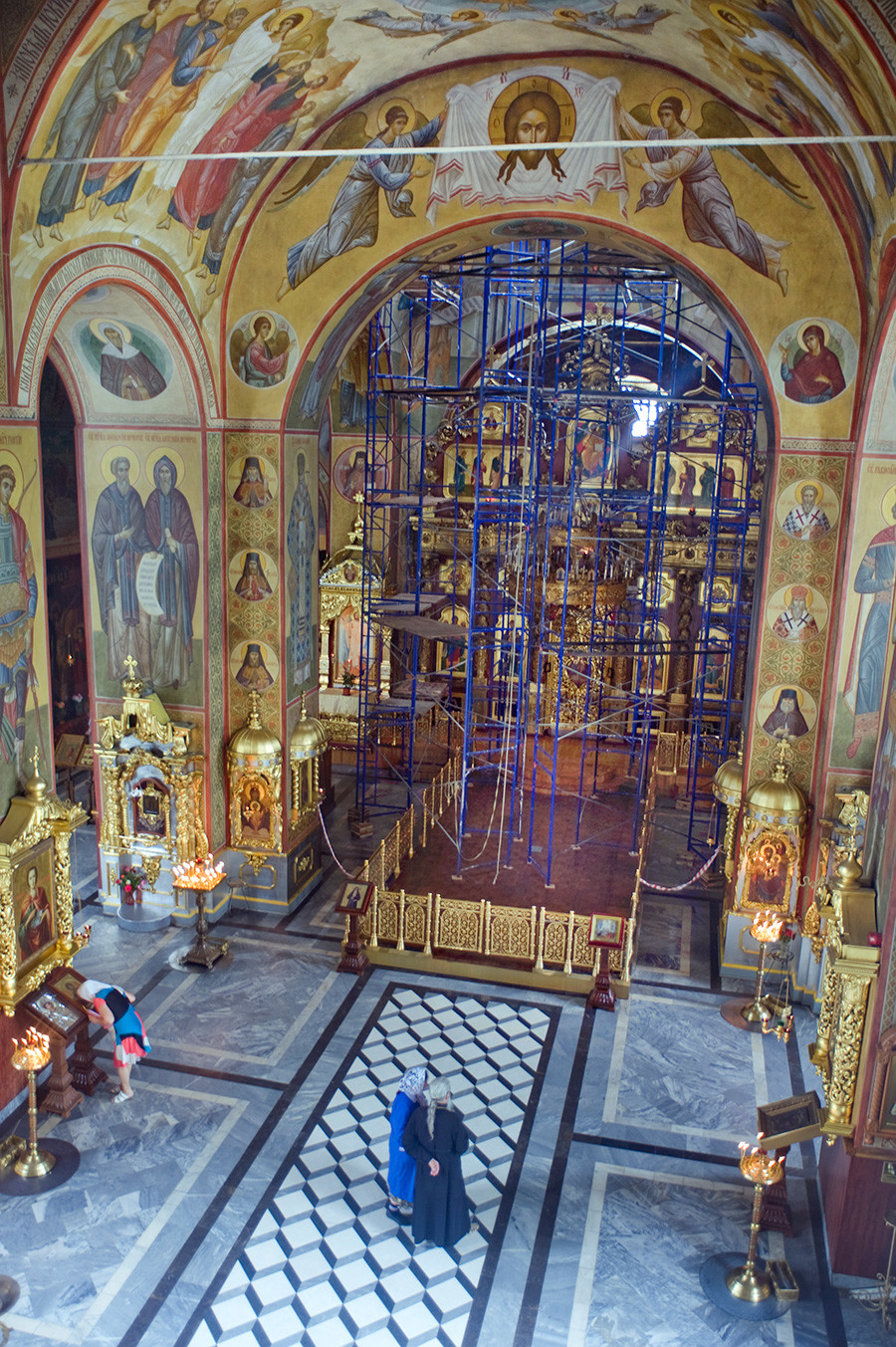
Cathedral of the Transfiguration, interior. View east from choir gallery toward icon screen. June 24, 2015
William Brumfield
The primary shrine of Belgorod is the neoclassical Cathedral of the Transfiguration, consecrated in 1803. Closed in the late 1930s, the cathedral was reopened during the war and again closed in 1962 as part of the Khrushchev era anti-religious campaign. The cathedral was returned in 1992 and served as the center of the Diocese of Belgorod and Stary Oskol.
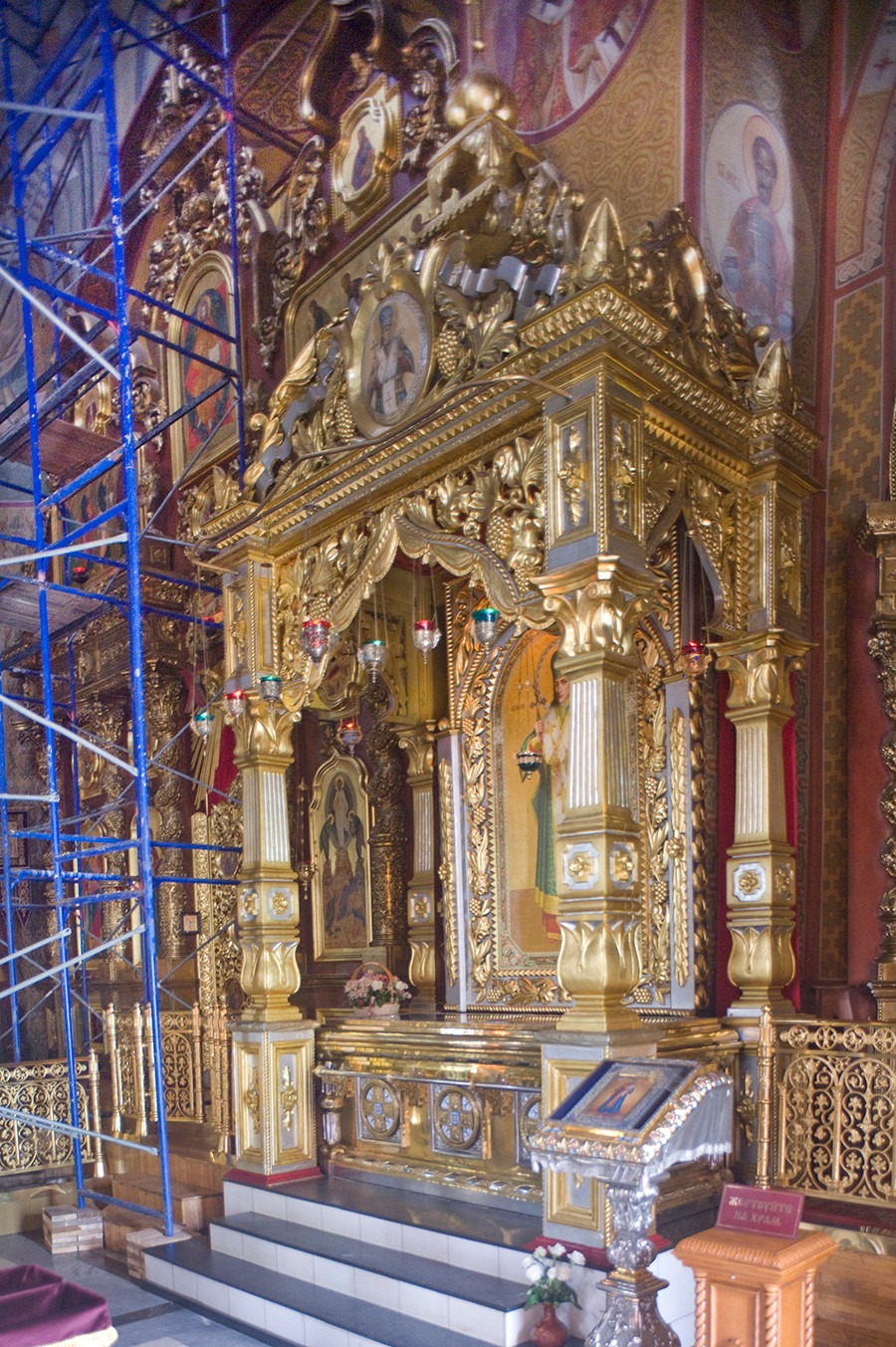
Cathedral of the Transfiguration, baldacchino with relics of St. Ioasaph, Bishop of Belgorod ( relics transferred from museum in 1991). June 24, 2015
William Brumfield
Rail hub
A major stimulus to Belgorod’s development occurred in 1869 with the opening of a railroad station as part of the Kursk-Kharkov line. Additional lines to the south transformed Belgorod into a major rail junction.
With improved transportation, the region’s abundant chalk beds became an important industrial asset (much to the detriment of their archeological value). With an expanded industrial base, Belgorod’s population doubled to some 28,000 by 1913.
The railroad network also permitted Prokudin-Gorsky easy access during in a busy travel period in the fall of 1911. On Sept. 4 (in the “old style,” or Julian calendar, 13 days behind the Gregorian calendar used elsewhere in Europe) Belgorod hosted an event that attracted widespread attention — the solemn celebration of the recently canonized Ioasaph of Belgorod.
Celebrating a holy man
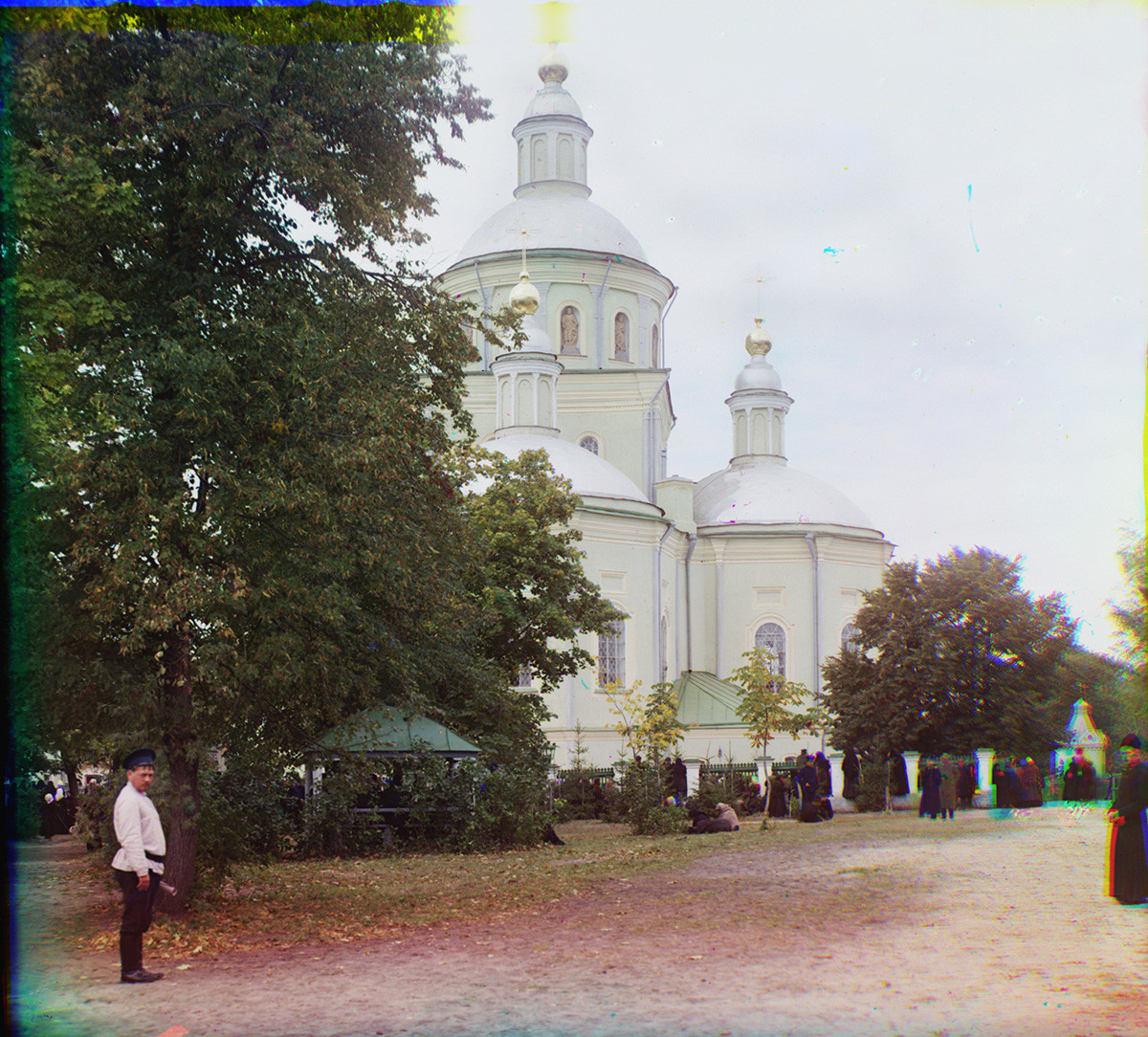
Trinity Cathedral, Trinity Monastery, east view. Site of original tomb of St. Ioasaph. Demolished in 1927. September 4 (O.S.), 1911
Sergey Prokudin-Gorsky
Bishop Ioasaph (Gorlenko) was born on September 8, 1705 in the Ukrainian village of Priluki. During the reign of Empress Elizabeth, he advanced rapidly in the Orthodox Church hierarchy and in 1748.was appointed Bishop of Belgorod and Oboyan.
During the relatively short period of six years, Ioasaph became widely venerated for his good works and effective pastorship. Upon his death in December 1754, his body was entombed in Belgorod’s Trinity Cathedral, built in 1690-1707 and subsequently the center of Trinity Monastery in the 19th century.
Over the ensuing decades, Ioasaph’s relics gained a reputation for miraculous healing properties, and a campaign for his sanctification gained momentum in the 1880s. In December 1910 the Holy Synod (the governing body of the Russian Orthodox Church) approved his sainthood, with the support of Nicholas II.
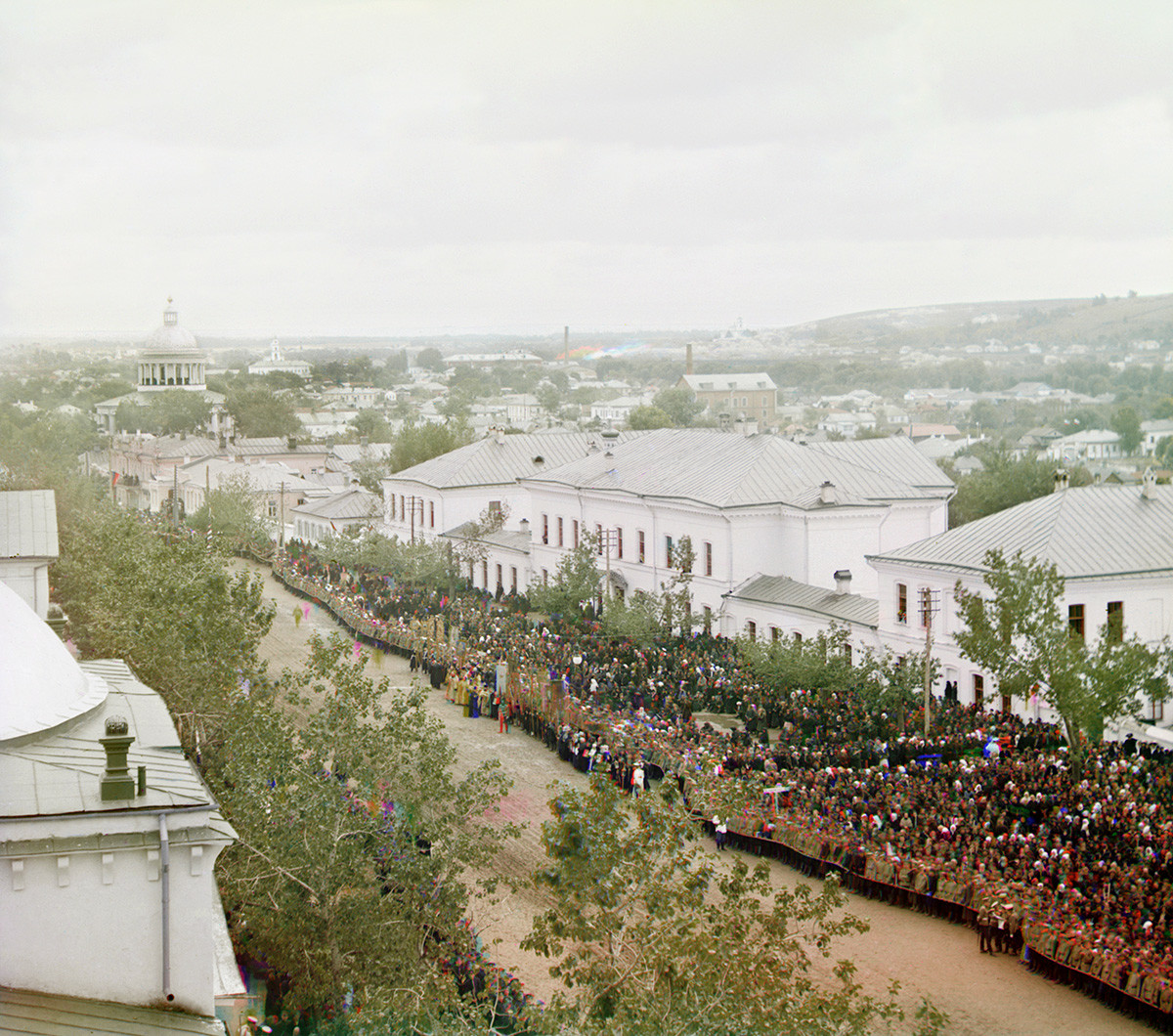
Cathedral Square, view east from Trinity Monastery bell tower on September 4, 1911. Dignitaries & crowds gathered for Procession of the Cross in homage to the canonization of St. Ioasaph. Left distance: domed Cathedral of the Nativity of the Virgin Convent
Sergey Prokudin-Gorsky
On the day of the ceremony in Belgorod, Prokudin-Gorsky made two photographs with his cumbersome box camera. One of the photographs shows the Trinity Cathedral, where Ioasaph’s relics were enshrined. The other, taken from the monastery bell tower, is one of Prokudin-Gorsky’s most remarkable, both as a historical document and for its depiction of masses along Cathedral Square waiting for the solemn Procession of the Cross. Some 200,000 people were estimated to have gathered for the ceremony celebrating Ioasaph’s canonization. This view shows throngs restrained behind a long cordon of military personnel in khaki tunics.
Just visible at the center next to clergy in ceremonial robes is the august personage of Grand Duke Konstantin Konstantinovich, who died in June 1915. Also in attendance was Grand Duchess Elizabeth Feodorovna, killed by the Bolsheviks in July 1918 and subsequently canonized.
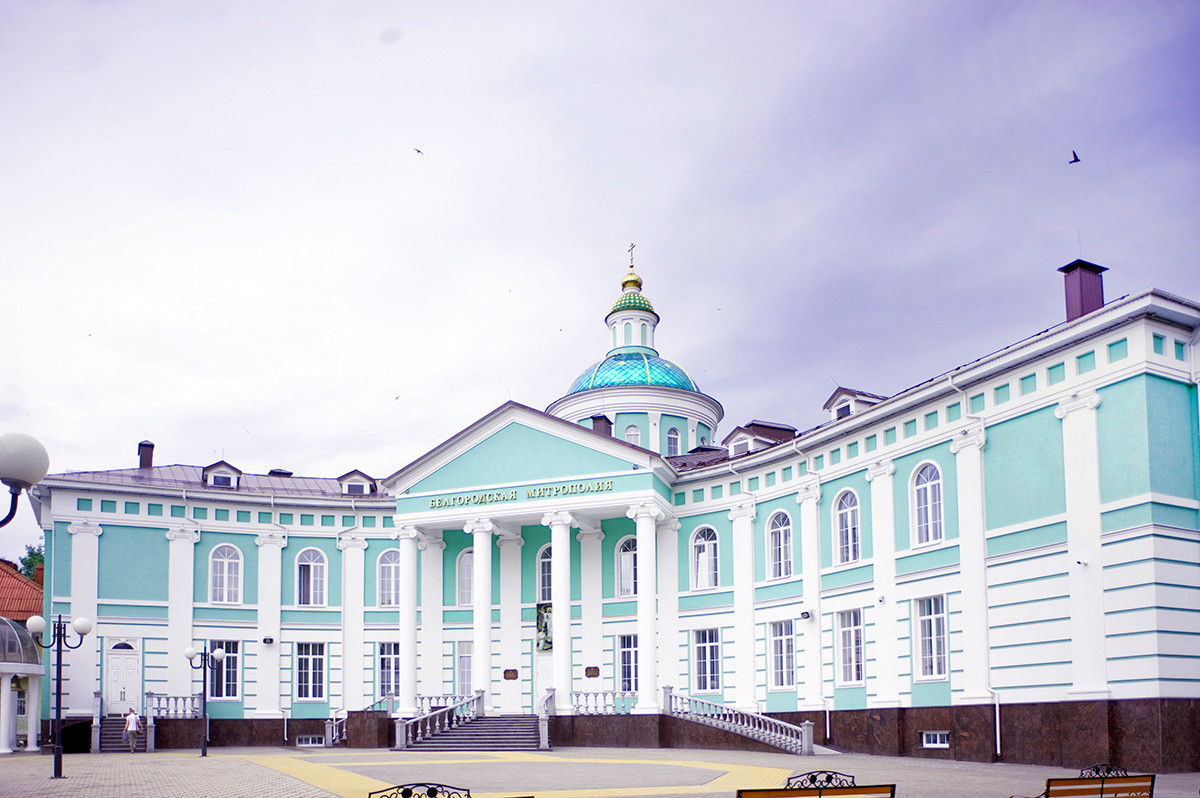
Headquarters of Belgorod Metropolitanate, with Trinity Church. Built on the site of Trinity Monastery. June 24, 2015
William Brumfield
Not present, however, was Emperor Nicholas II, who had been in Kiev on a state visit a few days earlier. Accompanying him was Prime Minister Pyotr Stolypin, who was shot on Sept. 1(old style) by a terrorist in front of the tsar during a performance of Rimsky-Korsakov’s opera “The Tale of Tsar Saltan”.
Despite hopes for his recovery, Stolypin died on Sept. 5, the day after Prokudin-Gorsky’s Belgorod photographs. Earlier in the year, Stolypin had expressed support for acquiring Prokudin-Gorsky’s photographic archive for the state, but with Stolypin’s death, the impetus for acquiring Prokudin-Gorsky’s collection waned. It ultimately vanished in the chaos of war and revolution, thus beginning the long, improbable saga that ultimately brought the collection to the Library of Congress.
A difficult century
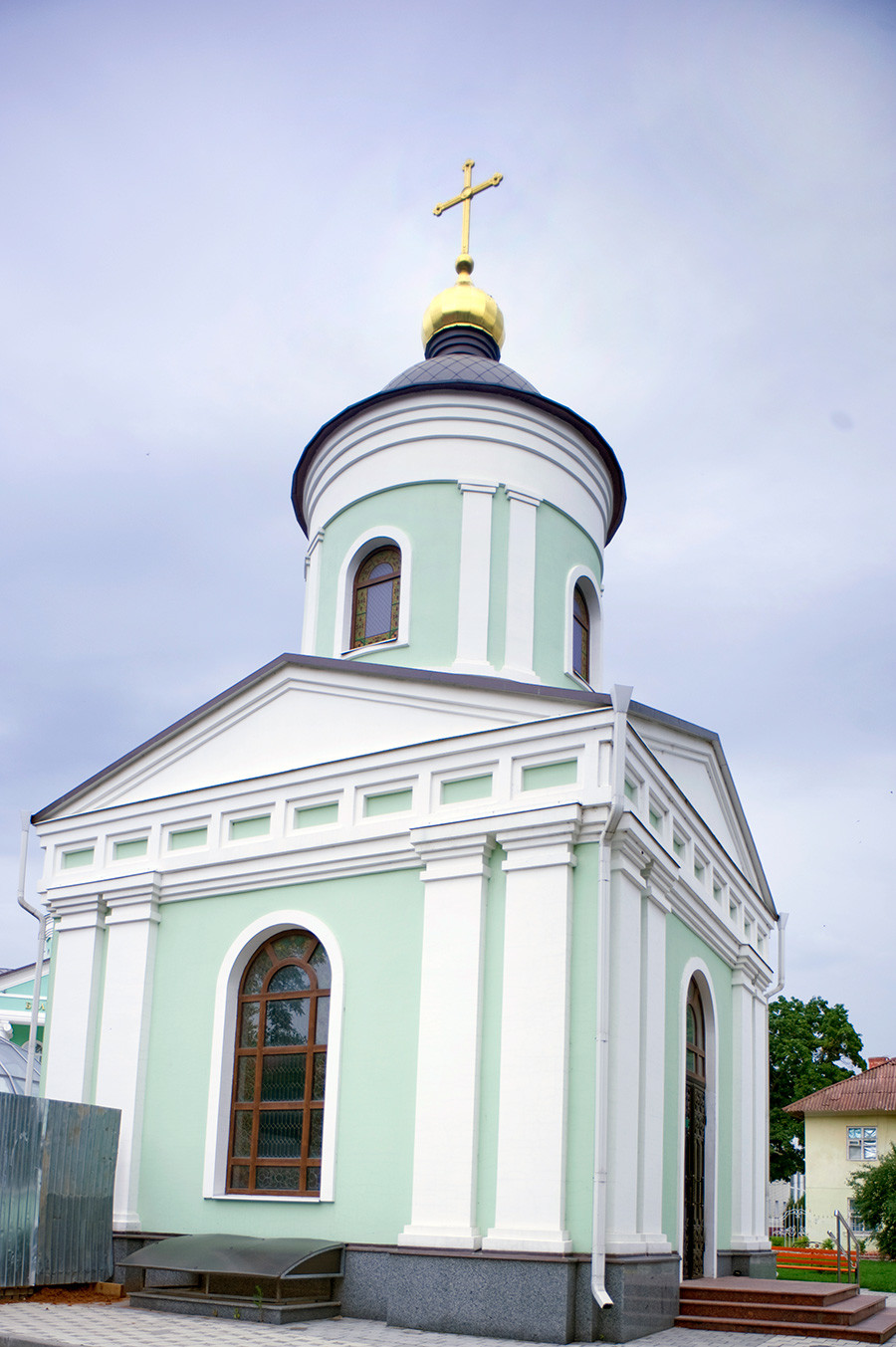
Chapel of St. Ioasaph of Belgorod. Built in 2011 on the site of Trinity Cathedral at the burial place of Ioasaph. June 24, 2015
William Brumfield
Indeed, subsequent decades dealt harshly with everything depicted in Prokudin-Gorsky’s Belgorod views. The Trinity Monastery was closed in the early 1920s, and its cathedral was demolished in 1927. The relics of St. Ioasaph were transferred to a museum, and the remaining monastery buildings fell in the 1930s.
Prokudin-Gorsky’s view from the bell tower included the large neoclassical Cathedral of the Nativity of the Virgin, center of a convent of the same name. Closed in 1923, it was demolished over a prolonged period beginning in the 1930s. From a historical perspective, a dark cloud hangs over these photographs.
After the collapse of the Russian Empire in 1917, Belgorod witnessed frequent changes in power among warring factions — Red, White, Ukrainian. Soviet authority in the region was consolidated only by the end of 1922. Over the next two decades, almost all the town’s churches were closed, and many were destroyed.
Belgorod’s greatest ordeal occurred following the invasion of the Soviet Union by Nazi Germany on June 22, 1941. During the chaos of the Soviet autumn retreats, Belgorod was seized on Oct. 24 and converted into a highly fortified position with a major rail junction.
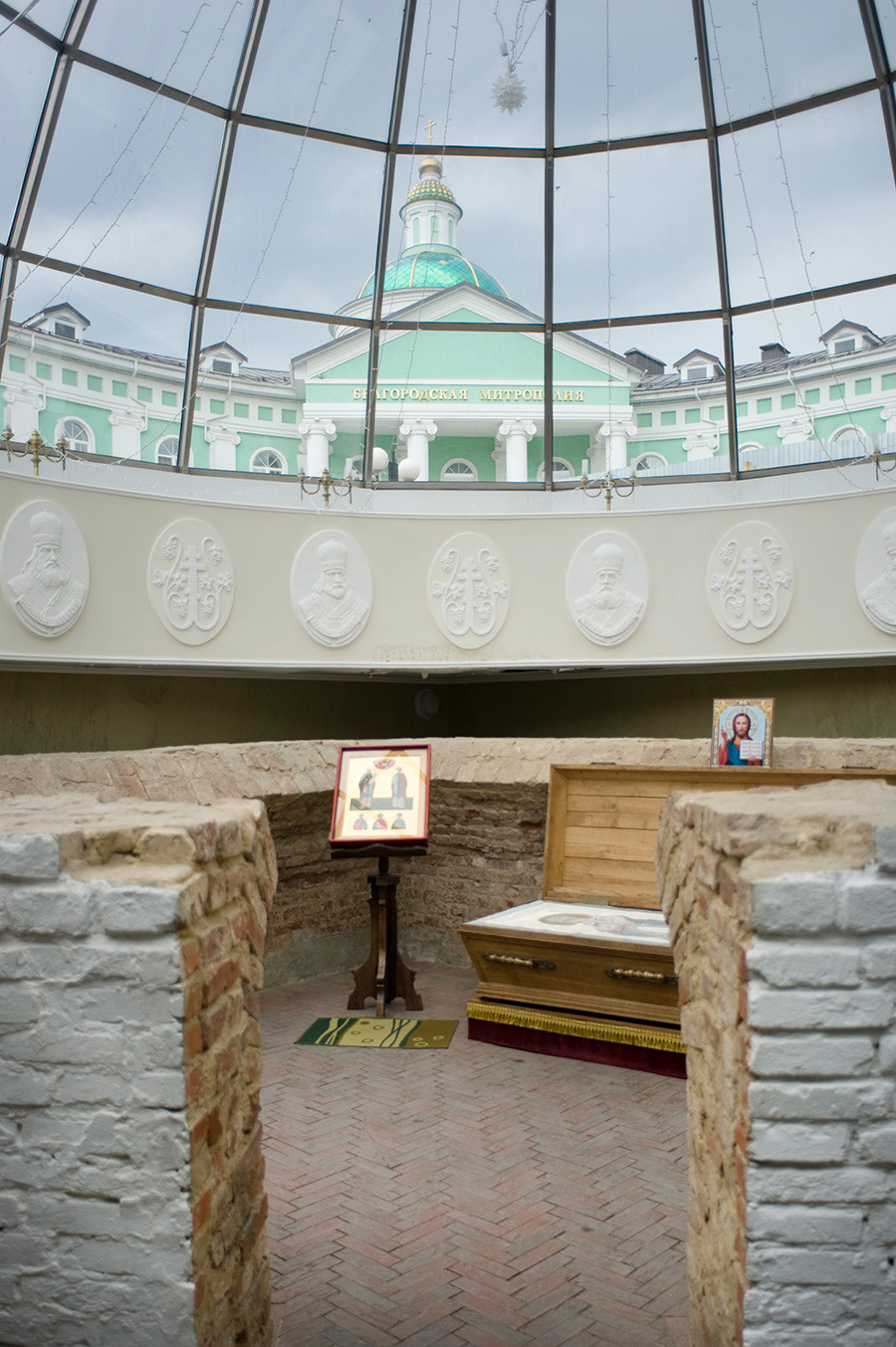
Burial crypt of Ioasaph, adjacent to the Chapel of St. Ioasaph. Located at the southwest part of the demolished Trinity Cathedral. Discovered by archeologists in 1911. Upper background: Belgorod Metropolitanate headquarters. June 24, 2015
William Brumfield
After the German defeat at Stalingrad, the Red Army moved rapidly westward and retook Belgorod on Feb. 9, 1943. Within a month, however, overextended Soviet forces faced a German counteroffensive (the Third Battle of Kharkov), and on March 18, Belgorod again came under German control.
Following the Soviet victory at the mammoth Battle of Kursk in July 1943, Belgorod was liberated on August 5. In Moscow, a massive artillery salute celebrated the victory, thus launching a practice that continued for major victories. From that time Belgorod became known as the “City of the First Salute”.
Reconstruction and rebirth
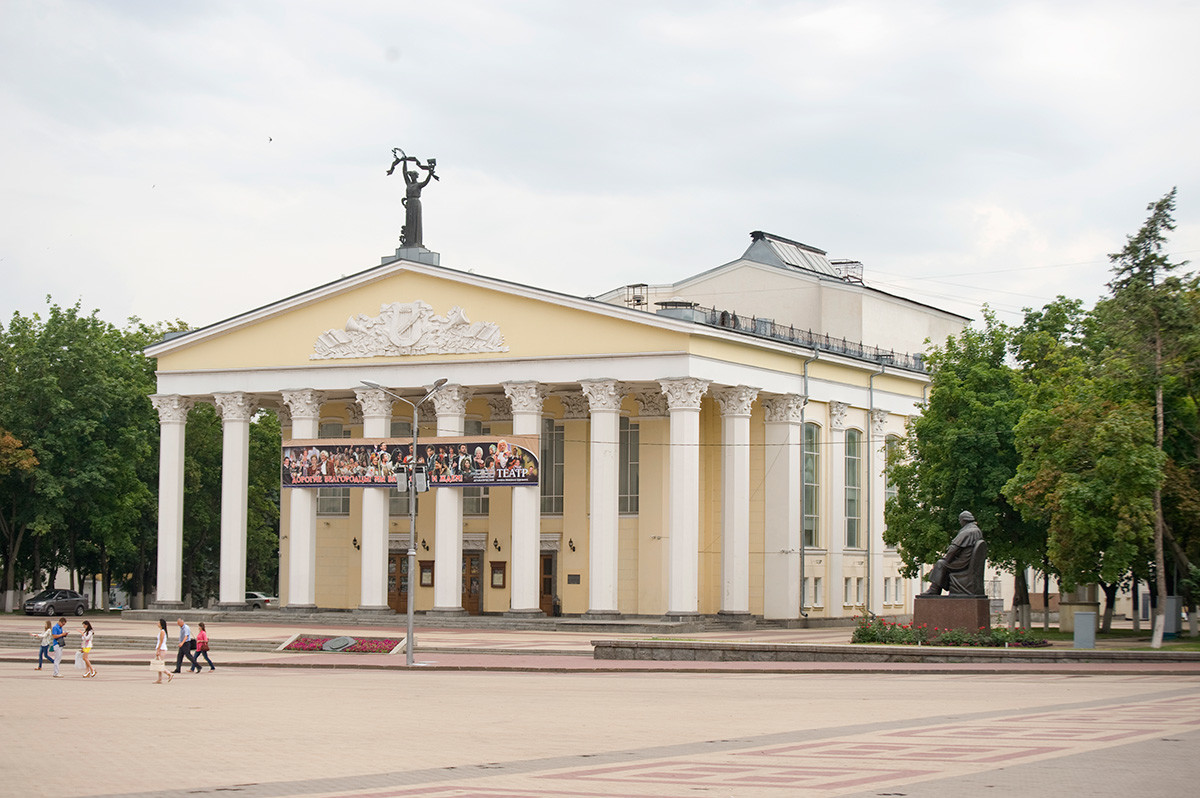
Shchepkin State Drama Theater, Cathedral Square. Built on the site of Convent of the Nativity of the Virgin (demolished during Soviet period). June 24, 2015
William Brumfield
Almost every building in the central part of Belgorod was destroyed or severely damaged, although some churches survived. Massive reconstruction efforts revived Belgorod’s status as an important regional center. Beginning in the 1990s, the Orthodox Church played a prominent role in the restoration of surviving churches and the construction of new ones.
The heart of Belgorod now centers on a renamed Cathedral Square, originally called Revolution Square — a major component of the city’s post-war reconstruction. The square’s north flank is occupied by the grandiose Regional Administration Building, which includes Philharmonic Hall.
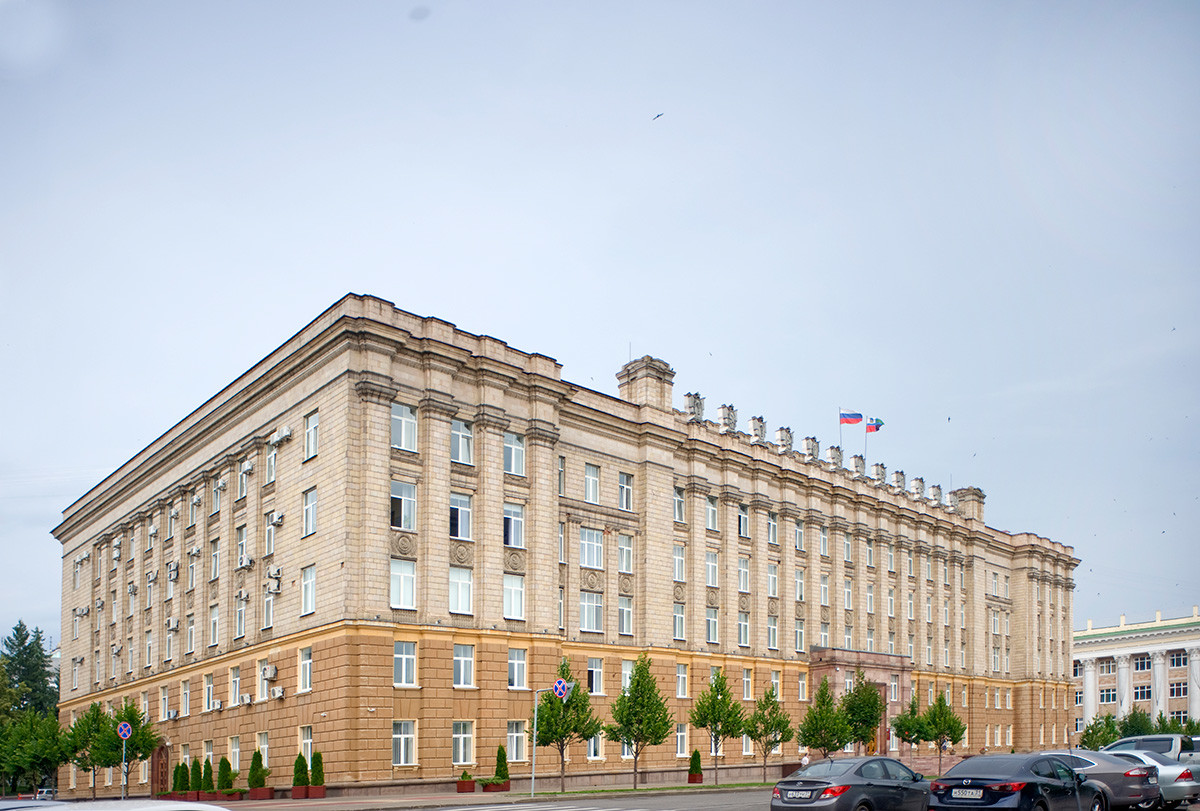
Belgorod Regional Administration Building, Cathedral Square (formerly Revolution Square). June 24, 2015
William Brumfield
On the opposite side of Cathedral Square is the neoclassical Drama Theater, built in the 1950s on the site of the demolished Nativity of the Virgin Convent. The square’s west side is marked by the Eternal Flame, a memorial to sacrifices during the Great Fatherland War.
As for the Trinity Monastery, its site is now occupied by a new Trinity Church, part of the administrative center for the Belgorod Metropolitanate. The complex also includes the foundation outlines of the destroyed Trinity Cathedral and the excavated crypt where Ioasaph was originally buried.
Within this space, a chapel dedicated to St. Ioasaph was completed in 2011 in homage to the centennial of his canonization. Thus, the event so vividly recorded by Prokudin-Gorsky in 1911 has been transformed on a new level of memory.
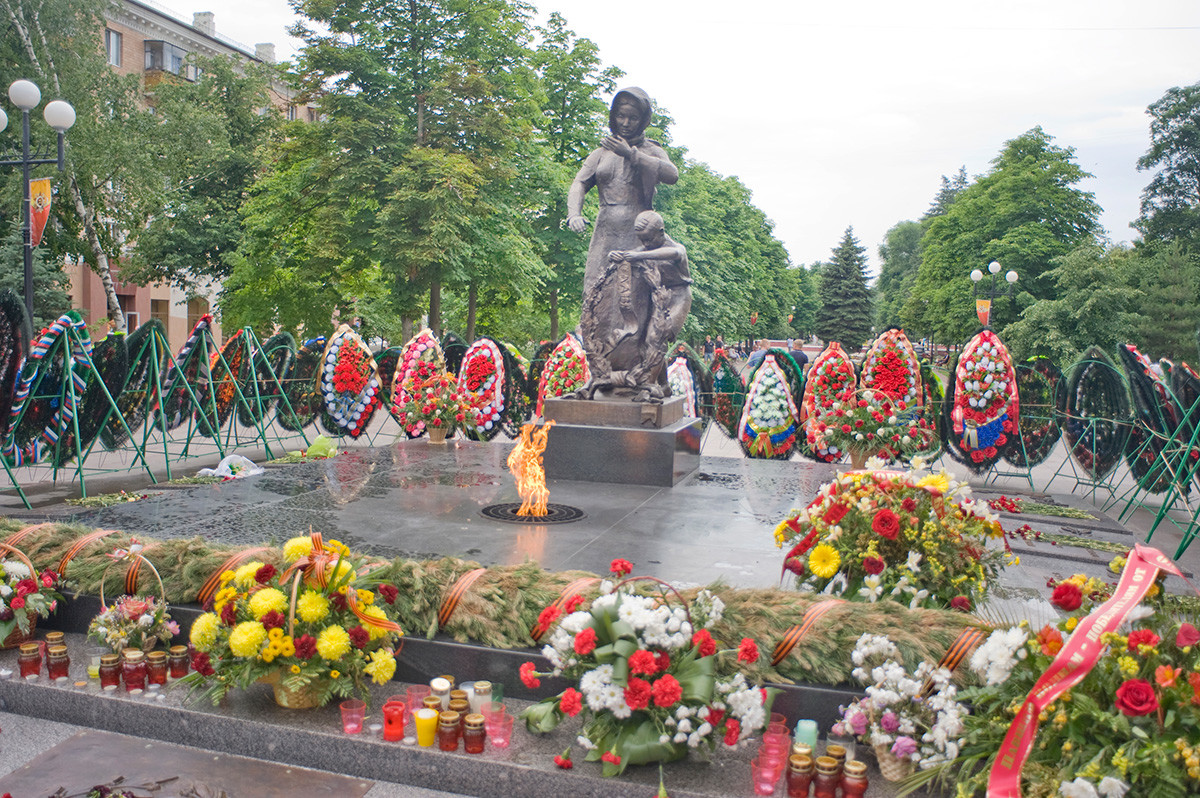
“Eternal Flame,” Cathedral Square. Memorial to sacrifices during Great Fatherland War. June 24, 2015
William Brumfield
In the early 20th century, the Russian photographer Sergey Prokudin-Gorsky developed a complex process for color photography. Between 1903 and 1916 he traveled through the Russian Empire and took over 2,000 photographs with the process, which involved three exposures on a glass plate. In August 1918, he left Russia and ultimately resettled in France where he was reunited with a large part of his collection of glass negatives, as well as 13albums of contact prints. After his death in Paris in 1944, his heirs sold the collection to the Library of Congress. In the early 21st century the Library digitizedthe Prokudin-Gorsky Collection and made it freely available to the global public. A few Russian websites now have versions of the collection. In 1986the architectural historian and photographer William Brumfield organized the first exhibit of Prokudin-Gorsky photographs at the Library of Congress. Over a period of work in Russia beginning in 1970, Brumfield has photographed most of the sites visited by Prokudin-Gorsky. This series of articles juxtaposes Prokudin-Gorsky’s views of architectural monuments with photographs taken by Brumfield decades later.
spacer
spacerspacer
 |
 |
Belgorod Marko De Foto

In Belgorod Russia there is a transmission tower in the form of the cities coat of arms...
A transmission tower – a true combination of art and engineering
“This project is fascinating! It shows how art and engineering come together to turn a prosaic structure into an exhilarating experience,” says Aarni Heiskanen, a construction expert and member of the BIM Awards jury that selected the winner of the 2020 Tekla Global BIM Awards.
The Russian steel design and manufacturing company Belenergomash won the Best Small Project category with its work on a transmission tower with a unique look and feel. Electricity transmission towers are typically steel lattice structures that look much the same the world over. But there are examples of these towers done differently, such as the one found in the Russian city of Belgorod.
Set on the banks of the Vezelka river, the tower is a striking design comprising the two main elements of Belgorod’s coat of arms: a silver eagle with its wings spread and a yellow lion on its hind legs. It was built as part of a broader project to improve the city’s infrastructure for citizens and tourists alike, including reconstructing sections of two 110 kV overhead lines. Standing at 26.3 meters in height, the tower both lights up the city and brings its skyline to life.
Tekla Structures at the core
The tower was designed and manufactured by Belenergomash, a subsidiary of Russian steel giant OMK. Prominent examples of their work include the Lakhta Center skyscraper in St. Petersburg and steel fabrication for five 2018 FIFA World Cup stadiums. The company has also made other transmission towers in interesting designs: one in the shape of a pair of soccer players, and the other in the shape of a skier (for the 2014 Winter Olympics in Sochi).
Belenergomash has some 3600 employees, with almost a third of them working on designing and producing steel constructions. The company has used Tekla Structures for this work since 2008.
“We use Tekla software to design steel structures and concrete foundations. Tekla also helps us to create design schemes for calculations,” says Dmitry Dolzhenkov, a Tekla Support Specialist at Belenergomash.
“We use Tekla Structures for a lot of our work, including steel detailing, drawing parts, creating assembly plans, and exporting DSTV files to our workshop,” he says. “And it’s not just our manufacturing people who use the software; our technologists, planners and salespeople all use the Tekla model in their work. We rely on Tekla at all stages of production. The software also has great interoperability with other programs used by our customers to calculate loads and requirements.”
|
Tekla Structures – Wikipedia |
|
Tekla Name Meaning | What Does Tekla Mean? – Meaning of … – Namesgram |
|
Tekla – Wikipedia |
|
Meaning, origin and history of the name Thekla |
Learn more: How Sisttemex uses BIM for steel tower production
Accurate design, quick construction
The Belenergomash team worked quickly to get the Belgorod transmission tower done during the first half of 2019 so it could be officially taken into use on August 5th – the city’s annual day of celebration. Design work kicked off in February, the steel was modeled through May and manufactured in June, and the structure was erected in July.
SPACER
SPACeR
| Unable to find any definition or etymology for Belenergomash I broke it down into parts until I could find etymology and meaning. Belen-ergo-mash |
|
Meaning, origin and history of the name Belén |
|
ergo | Etymology, origin and meaning of ergo by etymonline |
|
mash (n.) “soft mixture, mass of ingredients beaten or stirred together,” late Old English *masc (in masc-wyrt “mash-wort, infused malt”), from Proto-Germanic *maisk- (source also of Swedish mäsk “grains for pigs,” German Maisch “crushed grapes, infused malt,” Old English meox “dung, filth”), possibly from PIE root *meik- “to mix.”
|
|
Full name of the organization: ZAKRYTOE AKTSIONERNOE OBSHCHESTVO “BELENERGOMASH” TIN: 3123112366 (region of TIN receipt – Belgorod Oblast) KPP: 366101001 PSRN: 1043107039690 Location: 394007, Voronezh Oblast, Voronezh, pr-kt Leninskii, 119L Line of business: Wholesale trade through agents (for remuneration or on a contractual basis) (OKVED code 51.1) ..
|
The steel for the tower weighs 33 tons and comprises more than 5800 separate parts. These are joined together through an almost equal number of bolted joints, and the entire structure is installed on a foundation of 91 cubic meters of reinforced concrete. The steel is protected from corrosion through a hot-dip galvanizing technique.
“Due to our trust in the precision of elements produced and assembled in Tekla Structures, our factory did not need to do any assembly testing on the transmission tower parts prior to their delivery to the site,” says Dolzhenkov.
“We exported the IFC Model from Tekla with additional properties, and the on-site team used Trimble Connect to identify assemblies and bolt groups for quick installation,” he says. “Thanks to the accuracy of the model and its parts, the on-site team was able to work quickly to get the structure up and running. There were no additional queries about our assembly plan.”
“Due to our trust in the precision of elements produced and assembled in Tekla Structures, our factory did not need to do any assembly testing on the transmission tower parts prior to their delivery to the site.”
Dmitry Dolzhenkov, a Tekla Support Specialist at Belenergomash
“We enjoy working with the world’s best BIM software for steel structures, especially for unique, complex geometry projects,” says Dolzhenkov. “This was the first time we participated in the Tekla BIM Awards and we are proud of the high marks the jury gave our project.”

Belgorod Dnestrovsky
The oldest Belgorod fortress was built at the end of the 16th century on a chalk mountain. The discussion among historians about the time of the city’s founding, in 1593 or 1596, is not over and both versions have serious scientific basis. One of the first serious researchers of Belgorod history, Drenyakin, in the second half of the 19th century, adhered to the date of 1593, while reasonably exposing the attempts of some scientists already then to date the foundation of the city by Vladimir in the 10th century.spacer
Contemporary local historian Shmelev, trying to somehow open a three-year “black hole” from the moment of the decision to build until the actual appearance of the fortress, even put forward some arguments in favor of the existence of an unknown “first fortress” in the area of the current Rechnaya Street, allegedly originally built on a swamp, and after a couple of years – transferred to the mountain.
There are no archival documents from the period of foundation of the first Belgorod fortress, which would have contained a description of the city. The only source that sheds light from time immemorial is the “Travel Notes of Vasily Zuev from St. Petersburg to Kherson”, published in 1781, where a sketch of the ramparts of the lost ancient settlement is given. Only in the middle of the 50s of the XX century, the archaeologist A.V. Nikitin carried out excavations at the site of the first fortress, where the remains of ancient ramparts and ditches were still clearly visible. But already at this time part of the fortress was lost, in the 1860s during the construction of the railway the eastern part of the chalk mountain, on which the Kremlin was located, was collapsed. The location of the first fortress approximately corresponds to the location of the modern car market on Byelaya Gora.[18]
According to scientific excavations and surviving archival data, the first fortress outpost was erected in 1596. The site of the construction of the defensive facility was the top of the Belaya Gora (“White Mountain”). This is the highest point of the right bank of the Seversky Donets channel. On 17 September 1650, voivode Vasily Petrovich Golovin laid the foundation for the third Belgorod Fortress on the left bank of the Vezenitsa River, which flows into the Seversky Donets. Now on the site of the Third Belgorod Fortress is the modern city center. In the fall of 1650, a wooden fort with 11 towers was attached to the rampart of the Belgorod line, which runs from the fortress town Bolkhovets to the mouth of the Vezelka River in the area of the former brewery. Later, the wooden prison will become the Kremlin – the most fortified part of the new, already the third Belgorod fortress. And in 1668, to the east of the Kremlin, almost to the current Vokzalnaya Square, additional fortifications were erected. From the south, like the Kremlin, they adjoined the main shaft of the Belgorod line, and on the other sides wooden walls were erected. This part of the fortress was called the “earthen city”. The two parts of the city were connected by the Nikolskaya Passage Tower located in the eastern wall of the Kremlin. The position of the eastern wall of the Kremlin corresponded to the modern street of the 50th anniversary of the Belgorod Oblast. With the expansion of the borders of the Russian state, the military significance of the Belgorod fortress gradually decreased and by the middle of the 18th century, only the Kremlin remained from the formidable fortress.[19]
|
Bilhorod-Dnistrovskyi – Wikipedia |
|
Dnestrovsk – Wikipedia |

Law, State And Law
spacer
Flag And The Coat Of Arms Of The Belgorod Region. History, Description
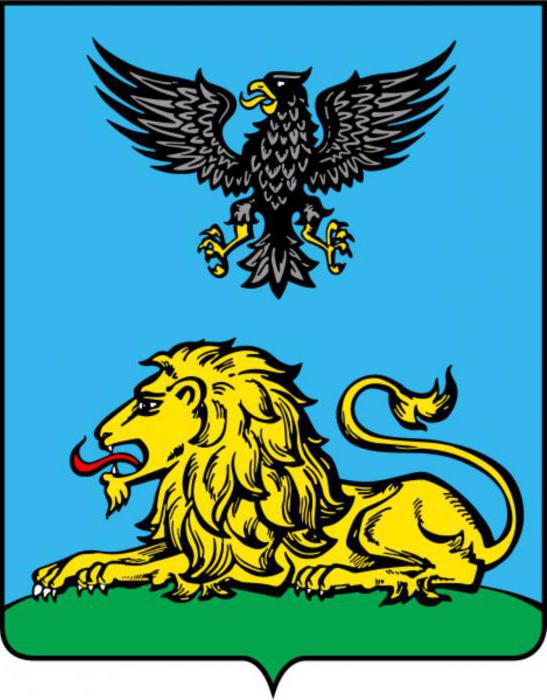
The situation with heraldry in different parts of Russia differs often cardinally. The coat of arms, even in the largest city, can express the absence of historical, national roots and an elementary heraldic tradition. Attitude to official symbols becomes an indicator of the historical and general culture of the leaders of individual cities and towns, entire regions and subjects of the Federation.
The coat of arms of the Belgorod region is an example of a competent attitude to such attributes, when the work with it is correctly placed at all levels.
THE LAND OF MILITARY GLORY
The Russian state since ancient times needed strong outposts on its southern borders. Since the final entry of territories, which contains today’s map of the Belgorod region, into the Russian state, it becomes clear the defensive purpose of the settlements that arise here. In the 16th century the construction of the Belgorod line began – a continuous defensive line from fortresses, military engineering structures and natural obstacles. She had to resist the predatory raids from the Crimean Khanate. 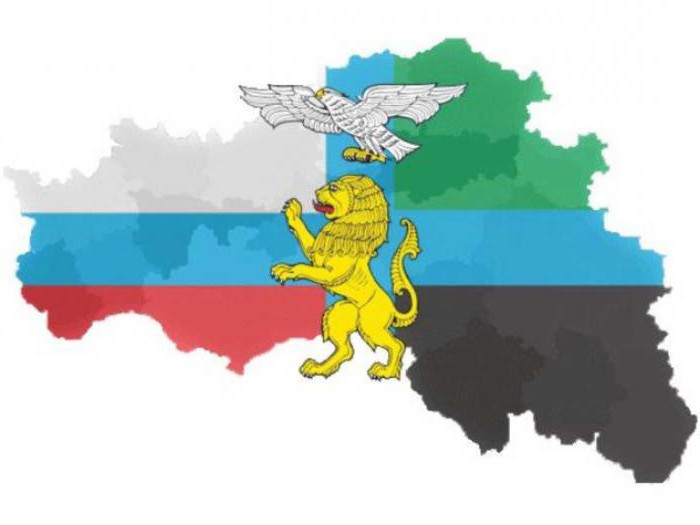
The first form of government was the Belgorod (or regiment) rank. In 1712 he was awarded Peter I for valor in the Battle of Poltava with a special banner with embroidered emblem on it. The modern coat of arms of the Belgorod region has a prototype of this emblem of three centuries ago.
BELGOROD PROVINCE
In 1727 the Belgorod province was formed, which existed for more than 50 years. It had its own coat of arms, developed on the basis of the emblem of the Belgorod Regiment and became the basis for all the heraldic attributes of cities and districts of Belgorod since the Russian Empire until our time. At the heart of the plot depicted on them, a symbolic depiction of the victory of Russian weapons in the battle of June 27, 1709 near Poltava: a running lion embodying Sweden, and the Russian eagle flying above it. The bird of prey became the main Russian heraldic symbol, being borrowed from the ancient kings of Byzantium, and the lion was depicted on the banners of Charles XII.
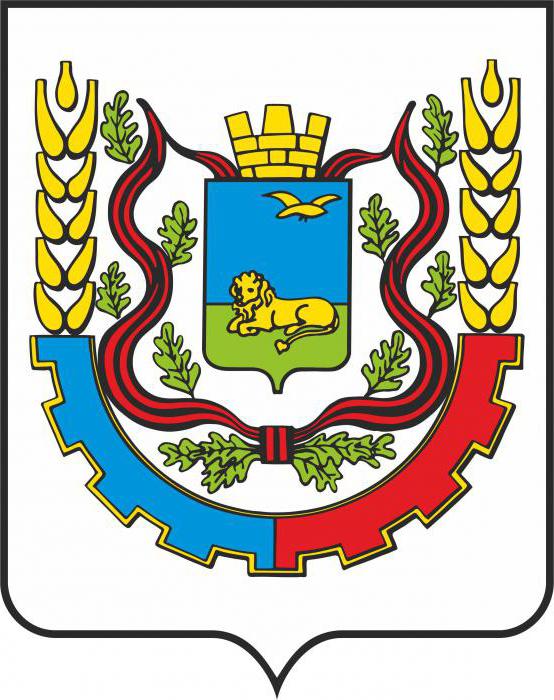 The coat of arms, approved March 3, 1730, is the oldest official state symbol of the city of Belgorod and the region: in a gold shield, in a blue field – a yellow lion, beneath it – a green earth, and above it – a single-headed eagle of black color.
The coat of arms, approved March 3, 1730, is the oldest official state symbol of the city of Belgorod and the region: in a gold shield, in a blue field – a yellow lion, beneath it – a green earth, and above it – a single-headed eagle of black color.
In the course of administrative reforms after 1779 Belgorod province was abolished, and re-established only in 1954.
BELGOROD REGION
In Soviet times, for the entire existence of the Belgorod region, it did not have its own heraldic symbol. The arms had no smaller units of administrative division, although the map of the Belgorod region numbered 31 districts, transferred to it from the Kursk and Voronezh regions.
COMMISSION ON HERALDRY
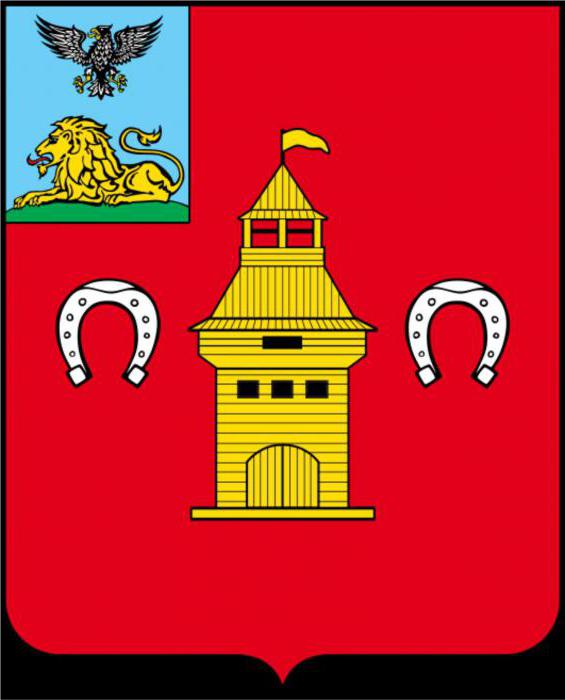 In 1994, a special public commission on heraldic provision was established in the region, one of the first in the country. It included the most famous local historians, historians and artists of the region. The purpose of her work was to recreate the arms and flags of the districts, cities and settlements, the development of local decoration badges, elements of uniforms and other symbols.
In 1994, a special public commission on heraldic provision was established in the region, one of the first in the country. It included the most famous local historians, historians and artists of the region. The purpose of her work was to recreate the arms and flags of the districts, cities and settlements, the development of local decoration badges, elements of uniforms and other symbols.
The first purpose of the commission’s work was the revival of regional state symbols and their creation for those regions and cities of the region where they had not existed before. By the forces of a specially created creative group, a proposal was prepared, including the coat of arms and the flag of the Belgorod region, which was sent for heraldic examination to the State Herald.
THE RESPONSE OF THE MAIN HERALD MASTER OF RUSSIA
In October 1995, the conclusion was reached, signed by the chairman of the Heraldic Council under the President of the Russian Federation Georgy Vadimovich Vilinbakhov. It noted the high level of materials provided on the coat of arms of the Belgorod region, the worthy quality of description and image of the main symbol of Belgorod. The coats of arms of the districts of the Belgorod region, as well as many towns and settlements of Belgorod region were approved. In February 1996, the coat of arms of the region was approved by a resolution of the regional Duma. In the Heraldic Register of the Russian Federation it is listed at number 100.
The modern coat of arms of the Belgorod region – its description and graphic embodiment – meets all the rules of heraldic science. The animals on it are depicted without exact follow-up to natural sciences, more ornamental and decorative, while preserving accurate references to the historical origin of the coat of arms. The description emphasizes the traditional meaning of color symbolism:
- The azure field on the shield is the color of the sky, a symbol of greatness, honesty, beauty.
- Green earth is the color of abundance, hope, joy.
- The black color of the eagle is a symbol of power, prudence, wisdom.
- The golden color of a lion is faith, justice, mercy.
- The red (scarlet) color of the tongue is courage, courage, fearlessness.
- Silver eyes, teeth and claws – truthfulness, nobility, purity.
The main regional heraldic symbol is included as an integral part in many emblems of the cities of the Belgorod region, which also corresponds to the classical rules of herbology.
FLAG OF BELGOROD
|
|
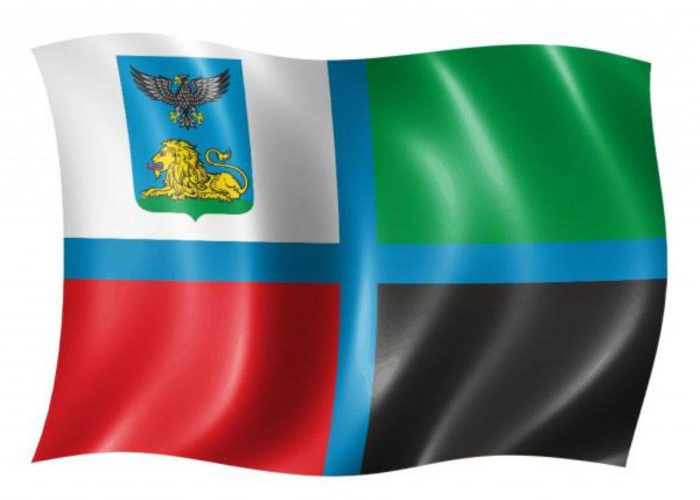 |
|
chernozem – chĕr′nə-zĕm″, chîr″nə-zyôm′
noun
The American Heritage® Dictionary of the English Language, 5th Edition.
|
|
Chernozem Definition & Meaning – Merriam-Webster |
FLAG OF THE CITY OF BELGOROD

 |
Belgorod Regional Chamber of Commerce
I could not find a definitive answer as to which of the above symbols is officially the one used by the Belgorod Chamber of Commerce. Either one of them does not symbolize anything good.
spacer
Belgorod State University
spacer
 |
|
Belgorod State Technological University
 |
|
Borissowka (Belgorod) – Wikipedia
I saw this coat of arms and flag in with the Belgorod Heraldry and found it intriguing. That gold figure in the center, which resembles a tree like formation, that seems to rise out of the crotch of trunk which resembles a man with his legs spread. Of course we have the crown above. Is this a representation of the bloodline, perhaps of the fallen?? We also see the templars cross on either side.
Every thing that I could find on the first syllable of the name BORIS, stated the likely root to be “WOLF”. If you have been following my posts you know that Wolfman, Werewolf and Shafeshifter is a common thread we see as we research the roots and sources.
Borissowka – Belgorod Oblast
As of 2013, four inhabited localities in Belgorod Oblast bear this name:
- Urban localities
- Rural localities
- Borisovka, Krasnogvardeysky District, Belgorod Oblast, a khutor in Krasnogvardeysky District
- Borisovka, Shebekinsky District, Belgorod Oblast, a selo in Shebekinsky District
- Borisovka, Volokonovsky District, Belgorod Oblast, a selo in Borisovsky Rural Okrug of Volokonovsky District
|
Boris (given name) – Wikipedia |
|
-ovka – Wiktionary |
Borisovka (Russian: Бори́совка) is an urban locality (a settlement) in Belgorod Oblast, Russia. It is the administrative center of Borisovsky District.
The settlement is included in the list of historical cities of Russia in 2002. Population: 12,553 (2021 Census);[5] 13,896 (2010 Census);[1] 13,083 (2002 Census);[6] 13,002 (1989 Census).[7]
Geography
Located on the Vorskla River (a tributary of the Dnieper), 7 kilometres (4.3 mi) to the east of the railway station Novoborisovka (in Lgov – Kharkov line). (Vorskla meaning Spring clover)
|
Dniester – Wikipedia |
In the town of Borisovka there are widespread natural landscapes. On the northern outskirts of the settlement there are two large forest areas – Forest on the Vorskla (section Belogorie Reserve, adjacent to the streets Kovalevka, Rudy, Sovkhoznaya) and Small Forest (adjacent to the streets October and Forestry). Inside Borisovka village located fen reed-sedge marsh area of 48 hectares. Also passes through the village of Vorskla River floodplain.
History
Sloboda Borisovka known since 1695, was part of the Hotmyzhskogo County. In 1705 it becomes the domain of Boris Sheremetev. It was here that he founded one of the largest musical theater, later translated in Kuskovo. During the preparation of the Battle of Poltava Hotmyzhsk along with Belgorod was the rear base of Russian troops. According to the census of 1877, the town had population of 17,502 residents.
After the October revolution of 1917 settlement was transformed into Borisovka Village, which was a part of Graivoronsky District in Kursk Oblast.
It was granted status of urban-type settlement in 1959.
On December 20, 2004, in accordance with the Law of the Belgorod Oblast number 159 the town was designated as a municipality Borisovka with urban settlement st
spacer

Belgorod Bilder | Fotogalerie von Belgorod – Hochwertige Sammlung
 |
 |
Belgorod, Russia – Circa January 2018: Pipe Organ at Hall of the Philharmonic Society... |
spacer
|
|
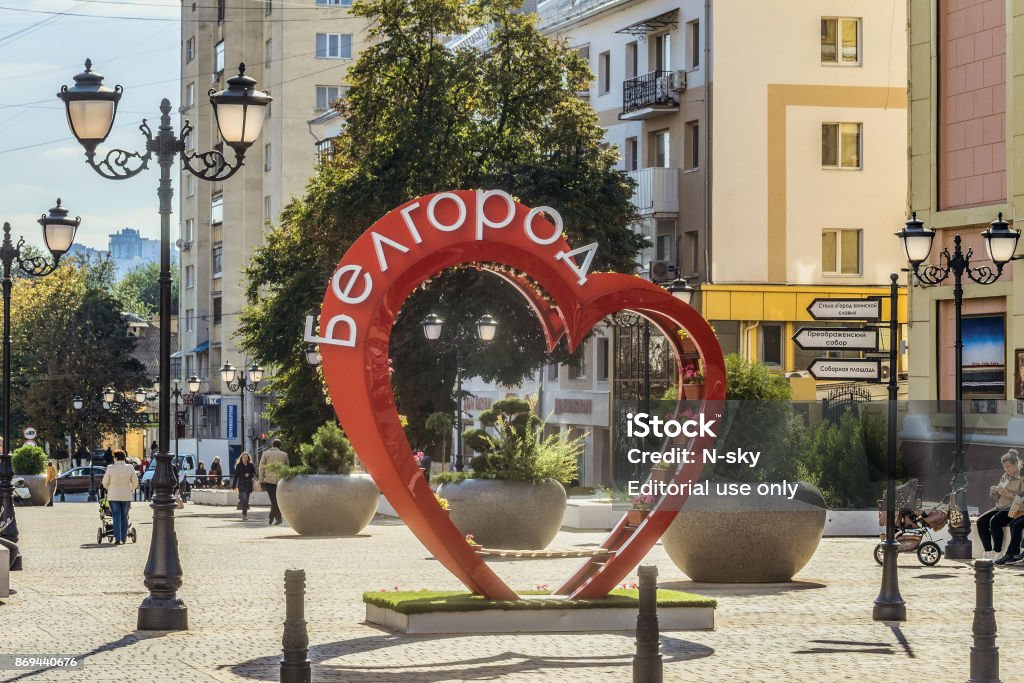 |
Bench of love in the shape of a heart with flower pots. Belgorod, Russia. stock photo
 |
 |
Belgorod, Russia. Emblem And Logos Close-up On Glass Mirror Facade Of Building Belgorodenergo
Belgorod, Russia – September 29, 2017: Emblem and logos close-up on glass mirror facade of building Belgorodenergo. Interregional Distribution Grid Company of the Center IDGC / MRSK of Center is a Russian energy company engaged in the transmission of electricity through electric grids.
..
spacer
Belgorod Oblast (Белгоро́дская о́бласть)
Belgorodskaya oblast, Province of Belgorod.
Cities and towns of the Belgorod Oblast
| Belgorod | Бе́лгород | 353,300 |
| Stary Oskol | Ста́рый Оско́л | 215,898 |
| Gubkin | Russian: Гу́бкин | 86,083 |
| Shebekino | Шебе́кино | 45,119 |
| Alexeyevka | Алексе́евка | 39,312 |
| Valuyki | Валуйки | 35,790 |
| Novy Oskol | Новый Оско́л | 20,892 |
| Stroitel | Строи́тель | 18,400 |
| Biryuch | Бирюч | 8,079 |
| Grayvoron | Гра́йворон | 6,196 |
| Korocha | Короча | 6,046 |
Population statistics from 2002 census.
About the Belgorod Oblast.
The Belgorod oblast is located on Russia’s western edge. It borders the Ukraine. It has a population of more then 1.5 million people. The administrative centre of the region is the city of Belgorod.
Belgorod means ‘White City’. It was named Belgorod because the city was rich in limestone. References to Belgorod dates back to the 1200s. The oblast was setup in 1954 with it’s administrative centre in Belgorod.
The battle of Prokhorovka, which was part of the overall battle of battle of Kursk, took place at the village of Prokhorovka. It is considered to be the largest tank battle in military history. The battle was fought by the German Wehrmacht’s Fourth Panzer Army and the Red Army’s 5th Guards Tank Army in 1943. Over 1000 tanks were engaged in the battle.
Belgorod Map — Satellite Images of Belgorod
original name: Belgorod
geographical location: Belgorodskiy rayon, Belgorodskaya Oblast, Russia, Asia
geographical coordinates: 50° 36′ 48″ North, 36° 35′ 14″ East
detailed map of Belgorod and near places
Welcome to the Belgorod google satellite map! This place is situated in Belgorodskiy rayon, Belgorodskaya Oblast, Russia, its geographical coordinates are 50° 36′ 48″ North, 36° 35′ 14″ East and its original name (with diacritics) is Belgorod. See Belgorod photos and images from satellite below, explore the aerial photographs of Belgorod in Russia. Belgorod hotels map is available on the target page linked above.


Administrative Divisions
Belgorod is divided into several administrative divisions.

Belgorod Oblast (Russian: Белгоро́дская о́бласть, romanized: Belgorodskaya oblast’) is a federal subject of Russia (an oblast). Its administrative center is the city of Belgorod. Population: 1,540,486 (2021 Census);[11] 1,532,526 (2010 Census);[6] 1,511,620 (2002 Census);[12] 1,380,723 (1989 Census).[13]
History
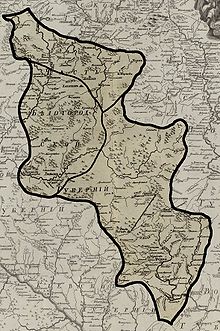 |
 |
Map of Belgorod Governorate (1745)
At the turn of the 17th century, a solid line of military fortifications was built in the area, stretching for almost 800 kilometers (500 mi). Zaporozhian Cossacks, who moved here because of the nobility and the tax burden, were in charge of the line defenses. Even more Cossacks moved to the area during the Khmelnytsky Uprising (1648–1657) and the internecine wars in the Cossack Hetmanate (1659–1679). Belgorod became the military and administrative center, after originating as an outpost on the southern borders of Russia.
Following the Battle of Poltava, Peter I granted to soldiers of Greater Belgorod the regiment flag.
From 1708 to 1727, the territory of the modern Belgorod Oblast was part of the Kiev and Azov governorates. In 1727, Belgorod Governorate was established from parts of Kiev Governorate. The governorate lasted until 1779. This territory was much greater than that of today, and the governorate incorporated territories modern Kursk, Oryol, and parts of Bryansk and Kharkiv oblasts. The coat of arms of the then-Governorate is still used by the modern Belgorod Oblast.
In 1775–1779, the territory of Belgorod Governorate was abolished and divided between the newly formed governorates and vice-royalties. The city of Belgorod and the area around it became a part of Kursk Vice-Royalty, while the southeastern uyezds became a part of Voronezh Governorate.

spcer
Nikolo-Tikhvinsky Monastery in 1900
During the 19th century and up until 1928 the territory of modern Belgorod Oblast remained part of the Kursk and Voronezh governorates. After the signing of the Treaty of Brest-Litovsk in April 1918, in January 1919 the territory was incorporated into the Ukrainian State under hetman Pavlo Skoropadskyi.
The current administrative-territorial boundaries of Belgorod Oblast were formed by the Decree of the Presidium of the Supreme Soviet of the USSR on 6 January 1954. The oblast was formed from several districts of Kursk and Voronezh Oblasts.
For the courage and resilience shown by the people of Belgorod Oblast in defense of the Motherland during the Great Patriotic War, and for progress in reconstruction and development of national economy. On 4 January 1967, Belgorod Oblast was awarded the Order of Lenin, and in 1980 the city of Belgorod was awarded the Order of the Patriotic War, first degree.
In 2007, the city of Belgorod received the honorary title of the City of Military Glory.
Natural resources
Over 40% of known iron ore reserves of Russia are concentrated in the oblast. Deposits are confined to the Kursk Magnetic Anomaly area. Among them are Korobkovsky, Lebedinskoye, Stoylenskoye, and prospective Prioskolskoye iron ore deposits in Stary Oskol District, Bolshetroitskoye in Shebekinsky District, as well as Yakovlevskoye and Pogremetskoye fields.
Identified and explored in varying degrees are the large deposits of bauxites, apatites, underground mineral waters, and numerous deposits of construction materials such as chalk, sand, clay, and more. There are also known occurrences of gold, graphite, and other rare metals. Geographical features make the oblast likely to have deposits of platinum, hydrocarbons, and other minerals.
Culture
The Belgorod region played a significant role in the evolution of Russian culture.[15] It was inhabited by different tribes besides East Slavs and was one of the earliest Rus’ principalities. Belgorod region played an important role in the Russian wedding tradition of the Rushnyk. Belgorod is also famous for its wood carving.
Meaning
Belgorod rushniks, Central Russia
The rectangular shape of the fabric indicates a life’s journey and the ornamentation captures the cultural ancestral memory of the region.[3] The material used is either linen or hemp. The act of spinning thread and the process of weaving linen embodies spiritual power dating back to the ancient deity Mokosh who is often represented in embroidery. The needle has its own energy, an idea similar to acupuncture, and the color of the thread has sacred meaning. Red represents life and is the main color used. A rushnyk is given to a baby at birth, it follows the person throughout life and is used in the funeral service after death.
 MOKOSH is the life-giving goddess in ancient Slavic mythology, inherited from the pre-Indo-European pantheon and debased during the early Christian era. She is the only female deity mentioned in the Kievan pantheon established by Vladimir I in 980 ce. In northern Russia, she has survived as a house spirit, Mokysha or Mokusha; a tall woman with a large head and long arms, she shears sheep at night and spins flax and wool. Her name is connected with spinning and plaiting (Lithuanian meksti, makstyti, “to plait,” and mākas, “shirt”; Russian meshok, “sack, bag,” moshna, “pouch”) and with moisture (*mok – or *mokr -, “wet, moist”). These associations suggest her ties with the life-giving and life-taking goddess of Old Europe—that is, with Fate, the spinner of the thread of life and the dispenser of the water of life. Menhirs (kamennye baby ), venerated in some Slavic areas into the twentieth century (and some now called Maria or Mary ), seem to be connected with this ancient goddess, who possessed healing powers. Paralytics, the blind, and the deaf offered flax, wool, and sheep to these stones. In the Christian era, Mokosh was superseded by Paraskeva-Piatnitsa (“Friday, fifth day”) or Lianitsa (“linen washer”). In the Russian Orthodox tradition she is identified as Saint Paraskeviia (from the Greek paraskevi, “Friday”). Friday was a day sacred to the goddess and was characterized by taboos on women’s work. In Carnival processions, the saint’s image was that of a woman adorned with flax, her hair hanging loose and her hands extended. Legends speak of the miraculous powers of healing springs or river sources associated with Paraskeva-Piatnitsa. In the Russian ritual called mokrida (from mokr -, “wet”), a sacrifice to her consisted of flax, wool, thread, or woven articles such as towels and shirts. Her most important holiday fell on October 28, a day within the annual period of flax preparation. Women may not work on this day. Disregard of this rule may bring on blindness or some other malady, or may even result in death. Piatnitsa may transform intransigent women into frogs. Posts and shrines in her honor were built at crossroads, and wooden images of her were erected as late as the twentieth century. In northern Russia, old icons testify to the continuing importance of this pre-Indo-European goddess in Christian guise. In them, Saint Paraskeviia, who replaced Mokosh, is shown as one of a saintly triad, along with Saint Elijah (Il’ia), who replaced the Indo-European deity Perun, and Saint Blasius (Vlasii), who replaced the Indo-European deity Veles-Volos. |
Rushnyk Etymology
Words with the common suffix “-nyk” (“-nik”), denoting agent nouns, indicate a general association of the new word with the base one.
- Rushnyk: from ruka, hand
- Na-: a prefix meaning “on”, i.e., the thing is supposed to be put onto something
- Pidnozhnyk: from pid (=under) and nohy (=feet)
бог – Wiktionary
Religion

According to a 2012 survey[23] 50.5% of the population of Belgorod Oblast adheres to the Russian Orthodox Church, 8.1% are nondenominational Christians (excluding Protestant churches), 1.7% are Orthodox Christians who don’t belong to the Russian Orthodox Church. In addition, 22.2% of the population declares to be spiritual but not religious, 10.5% is atheist or irreligious, and 7% follows other religions or did not give an answer to the question.[23]
Zedekiah’s Cave
An ancient quarry rediscovered by a dog and claimed by biblical kings, a German cult, and the Freemasons.
THE LIMESTONE ROCK QUARRY KNOWN as Zedekiah’s Cave under the Old City of Jerusalem has been a center of legend and ceremony for thousands of years.
There are several stories about the cave that are matters of faith. Legend says that stones from the quarry were commissioned by King Solomon and used to build the lost First Temple, which is why the site is sometimes referred to as Solomon’s Quarries. Another biblical king, King Zedekiah, is said to have attempted to flee a besieged Jerusalem for Jericho through this cave. When he was captured by henchmen of the Babylonian King Nebuchadnezzar, his sons were murdered in front of him before his eyes were put out. He spent the rest of his life blind and imprisoned. The drops of water that trickle through the cavern’s ceiling are today known as “Zedekiah’s tears.” Still another legend marks the quarry as the final resting place of Korah, who led a rebellion against Moses and was swallowed up by the earth in a godly act of retribution.
What can be proven through archeology and historical corroboration, however, is perhaps equally remarkable. The 300-foot-long subterranean chamber is entirely man-made, hollowed out by generations of labor. The total size is estimated at around five acres. Around 50 CE, Herod the Great used this quarry for building projects, including the Second Temple and what is now the Western Wall. Suleiman the Magnificent would have the cave sealed during the 16th century, fearing that invaders would be able to use it to dig tunnels right into the heart of Jerusalem.
The cave remained sealed until 1854, when an American missionary named James Turner Barclay discovered the entrance, after his dog ran into a small opening that had been revealed by heavy rainfall. In the 1880s, a German religious cult moved into the cavern, but was removed by Turkish and German authorities. The Freemasons were also drawn to the cave, as they hold particular kinship to King Solomon, who is believed to have been the first Grand Master. The group held their first ceremony in the cave in 1868 and the Freemasons of Israel continue to hold an annual ceremony in it every year.
The last known use of the cave as a quarry was for the building of the clock tower above the Jaffa Gate in the in early 1900s. However, anyone acquainted with the cavern’s long history knows there’s still time for many more tales to be told.
LIMESTONE LEARNING CENTER
Limestone and its magic!
Limestone:
Properties: Limestone is an assisting stone used to enhance healing properties, encourages purification, reminds us of our innocence, grounds and centers us and entices positive thoughts. Due to its grounding make-up of clay, sand, organic remains, iron oxide and other materials, many limestones exhibit different colors, especially on weathered surfaces. Limestone is the root of many crystals including, agate, calcite, dolomite, lapis and Septarian, just to name a few. Therefore, it takes on the metaphysical properties of its additional minerals. This is why limestone is such a mult-dimensional stone.
Folk Remedies: Limestone is a healing stone beneficial to overall health and well being. It gives relief for muscle spasms, nurtures, grounds and works primarily well on the Root Chakra.
History: Limestone is a sedimentary rock. Like most other sedimentary rocks, limestone forms in shallow, calm, warm marine waters and is composed of grains. Most grains in limestone are skeletal fragments of marine organisms such as coral or foraminifera. Other carbonate grains comprising limestones are ooids, peloids, intraclasts, and extraclasts. These organisms secrete shells made of aragonite or calcite, and leave these shells behind after the organisms die. Limestone often contains variable amounts of silica in the form of chert (chalcedony, flint, jasper, etc.) or varying amounts of clay, silt and sand carried in by rivers. Because of impurities, such as clay, sand, organic remains, iron oxide and other materials, many limestones exhibit different colors, especially on weathered surfaces.Their biological origin is often revealed in the rock by the presence of fossils. Limestone is partially soluble, especially in acid, and therefore forms many erosional landforms. These include limestone pavements, pot holes, cenotes, caves and gorges. Such erosion landscapes are known as karsts. During regional metamorphism that occurs during the mountain building process, limestone recrystallizes into marble.
spacer
Blast Furnace Steel Production Process
A blast furnace is a huge steel roughly cylindrical shell lined with heat-resistant brick. Steel production in a blast furnace is a continuous process. Hence, once steel manufacturing started, the production continues for years until the refractory lining is damaged or demand dropped. There are two processes by which steel is produced in a blast furnace
- The Bessemer Process for Steel production and
- The Open Hearth Process of Steelmaking
Steel manufacturing Principle of the Bessemer Process
The main raw materials for Steel production in a blast furnace are Iron ore, limestone, coke, and some scrap steel. These materials are charged into the blast furnace from the top and converted into molten pig iron. Next, a current of air is blown through the molten pig iron containing carbon, silicon, and manganese. These elements and some iron are oxidized. The carbon forms gas and escapes, But the oxidized silicon, manganese, and iron form a mixed ferrous-manganese silicate slag. This process is known as the Acid Bessemer Process.
The above oxidation process, especially the oxidation of silicon, produces a large amount of heat. This heat maintains the temperature and fluidity of the molten pig iron. If the content of silicon in the pig iron is very high, the heat evolved may be excessive, and cold steel scraps are added to the converter to lower the temperature.
Once the oxidation is completed, the produced mild steel contains a considerable amount of oxygen and maybe hydrogen which is rectified by spiegeleisen or ferromanganese additions. This is usually done when the metal is poured from the converter into the casting ladle.
All the reactions taking place in the converter are reflected in the flame which issues from the mouth of the converter. During the early part of the blow, when the manganese and silicon are being oxidized, the flame is short and of low luminosity, gradually increasing in length and luminosity as the blow proceeds and the carbon is eliminated. But the flame drops when decarburization is completed, and blowing is discontinued. Any prolongation of blowing after the drop of the flame results in the oxidation of iron and this is indicated by the number of brown fumes in the flame.
In the Basic Bessemer Process, the blowing is prolonged after the flame drops, and this period is known as the after-blow. The phosphorus is removed during the after-blow. The pig iron used in the basic process contains a low silicon and manganese content but is high in phosphorus. It is the oxidation of phosphorus that produces the necessary heat.
The removal of phosphorus necessitates a basic lined converter and a basic slag which is formed from lime added to the converter just before the molten pig iron is poured into it.
The procedure adopted in either the acid or basic process is similar. The molten pig iron is poured into the converter, which is in a horizontal position turned down so that the metal is away from the tuyeres. These tuyeres are fixed in the bottom of the converter and they supply the current of air. The blast is then put on, and the converter is rotated into a vertical position. Immediately the flame drops, the vessel is turned down again and the blown metal is poured into a casting ladle. At this stage, the finishing additions are usually made.
Hence, the process, whether acid or basic, consists of the following three stages:
- A hot metal supply.
- A suitable vessel for blowing the air through the molten pig iron.
- A casting ladle and ingot mold with an auxiliary plant, for teeming the steel into ingot form.
apacer

Pennant of K-329 “Belgorod” : submarines
IS-3 Belgorod legion-afv.narod.ru
New Details of Russian Belgorod ‘Doomsday’ Submarine Revealed
Russia’s latest super-sized submarine, Belgorod, has been a conundrum for interested observers. While its existence is far from secret, Moscow has gone to great pains to keep certain key details out of the public domain. While navies traditionally hide the screw, or propeller, from the cameras, in Belgorod’s case the reverse was true: the screws were on display at the 2019 launch ceremony, but no photographs of the forward section were ever published.
Belgorod’s secret is its arrangement of the primary weapon system: a new class of nuclear-tipped torpedos. Russian state media Izvestia reported on Feb. 11 that Belgorod is being prepared for tests with the new weapon called Poseidon, a massive nuclear torpedo which is shot forward out of the front of the submarine.
The Izvestia article’s timing matches fresh satellite imagery of the submarine in the northern Russian submarine base in Severodvinsk, which may show part of the tests.
In the absence of official photographs, commercial satellite imagery has become a primary source of information. Though the long Arctic nights and thick clouds have limited access to new imagery for many months, now as the Arctic winter is waning, commercial imagery satellites are once again more active over Severodvinsk.
On Feb. 10, an Airbus satellite took a high-resolution image of the harbor. Moored next to the quay is Belgorod with its torpedo tube doors appearing to be open. These tubes are not for ordinary torpedoes but rather the Poseidon nuclear-powered, nuclear-armed torpedo. It is one of Russian President Vladimir Putin’s so-called wonder weapons, together with hypersonic missiles and a nuclear-powered cruise missile.
The satellite imagery clearly shows two large openings in the bow. Each opening is roughly six feet (two meters) across, approximately three times the diameter of the openings for regular 21-inch (533mm) torpedoes. This is because the Poseidon weapon is about 20 to 30 times the size of a traditional heavyweight torpedo.
Revealed in 2015, the school-bus sized torpedo is a strategic weapon that is designed to slip under the U.S. ballistic missile defense network. The weapon is designed to “destroy important economic installations of the enemy in coastal areas and cause guaranteed devastating damage to the country’s territory by creating wide areas of radioactive contamination, rendering them unusable for military, economic or other activity for a long time,” according to a 2015 translation of the initial document by the BBC.
Previous reports indicate that Belgorod will be armed with six Poseidons. Being so large and nuclear powered, these are likely carried externally to the main pressure hull, so it is unclear whether all six tubes will have their own shutter doors or if they will be able to cycle through the two shutters seen in the satellite images.
One takeaway from the images is Belgorod probably has a forward hull between the two open shutter doors. This could allow regular torpedo tubes to be mounted in the bow, shooting over top of the sonar.
Although some reporting on the Poseidon implies Belgorod will be conducting test launches imminently, this is unlikely. It’s unclear if the submarine has ever conducted submergence testing, and just today the TASS Russian news agency reported the submarine is preparing to sail to sea for the first time.
The tests that the Izvestia article referenced are likely in-port mating and mechanical checks between the submarine and the weapon, which matches the satellite imagery showing the outer shutters open. This would likely be conducted with inert surrogate rounds where possible, given the safety implications of testing a nuclear-powered weapon with what is likely a minimally shielded reactor at the pier.
While the public image of Belgorod is becoming clearer, the particulars of the new Russian boat are still shrouded in mystery.
Tsar Bell: A unique monument of 18th century casting art and the world’s biggest bell
Twenty-two feet in diameter, 21 feet high, and weighing 450,000 pounds, the Tsar Bell is considered to be the largest bell in the world and a masterpiece of 18th-century Russian casting technology.
This colossal bell was cast in 1735 by a team of nearly 200 craftsmen under the supervision of Ivan Motorin and his son Mikhail. The empress Anna Ioannova, the niece of Peter the Great, ordered its creation. Today, the bell stands on a large pedestal beside the Ivan the Great Bell Tower in the grounds of the Kremlin in Moscow.
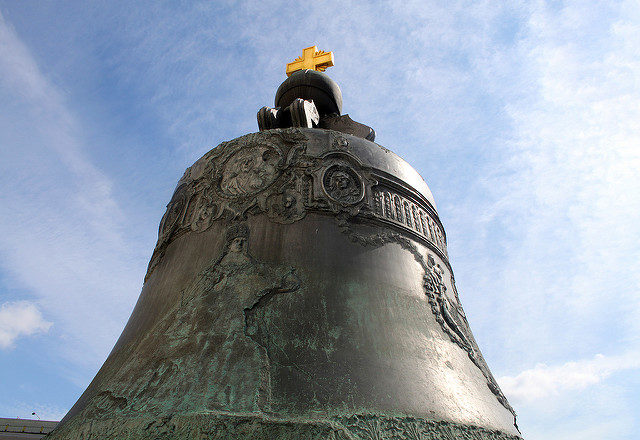
World’s largest bell. Photo Credit
This monument of 18th-century foundry art is also known as “Tsar Kolokol III,” because it was cast three times, with more metal was added each time. The first bell was cast during the reign of Boris Godunov (1585–1605) by Andrey Chokhov, a prominent Russian master bell caster who worked in Moscow more than 40 years.
|
Kolokol – Wikipedia |
After it was destroyed by a fire in the middle of the 17th century, caster Emelian Danilov used
its metal, along with new materials, to create the second Tsar Kolokol, during the reign of Tsar Alexey Mikhailovich. It weighed 220,000 pounds but was again destroyed by fire in 1701.
After Anna Ioannovna became empress, she ordered all the pieces to be cast into a new bell with its weight increased by another hundred tons. The job was assigned to local foundry masters, Ivan and Mikhail Motorin.
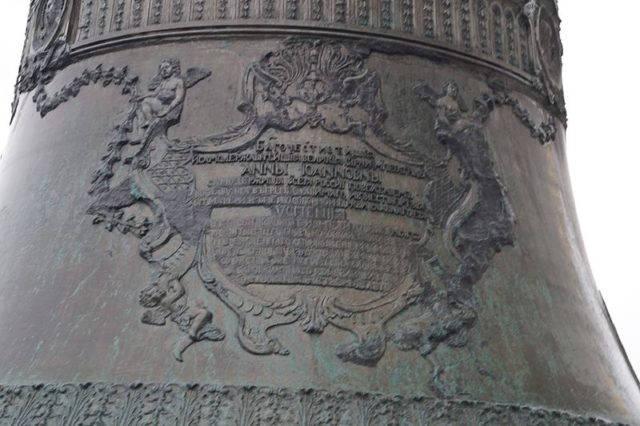
Cast in bronze by the casting-masters Ivan Motorin and his son Mikhail. Photo Credit
After months of preparation, casting work began at the end of November 1734. The casting of the enormous bronze bell was a giant task that took almost two years to complete. In 1737, when it was finally raised above the casting pit to cool before the last ornamentation was completed, a terrible fire broke out in the Kremlin.
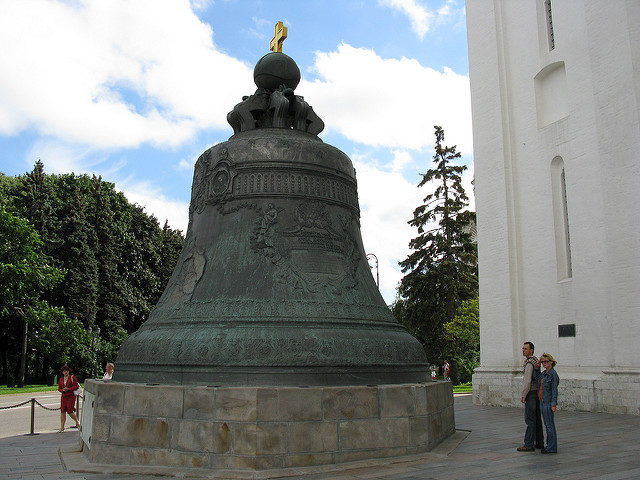
It is also known as the Royal Bell, Tsar Kolokol III, and Tsarsky Kolokol. Photo Credit
Soon, the fire spread to the wooden casting-frame that supported the bell, which fell back into its casting pit. In an attempt to prevent damage to the bell, guards threw cold water on it, causing a large piece weighing 23,000 pounds to crack off. This chunk alone weighs more than most bells in the world.
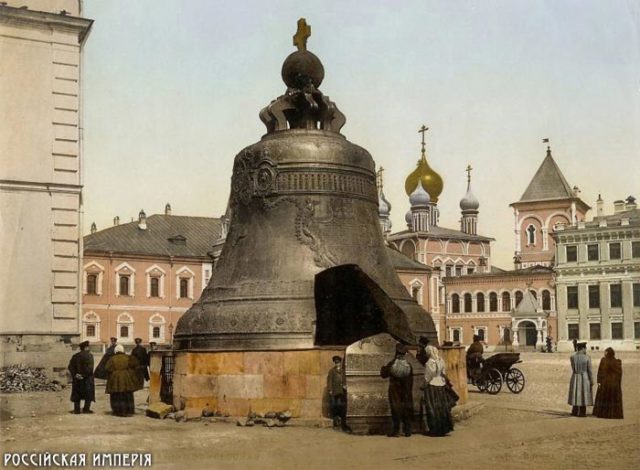
Pre-revolutionary Russian postcard of Tsar Bell in the Kremlin, before 1917. Photo Credit
The Tsar Bell remained in its casting pit on Ivan Square in the Kremlin for almost one hundred years. In 1836, it was finally raised out and placed on a stone pedestal by the French architect Auguste de Montferrand, who also created the ball-shaped decoration with a golden cross on the top of the bell. This French Neoclassical architect, considered one of the greatest architects in St. Petersburg’s history, was also the mastermind behind the famous Saint Isaac’s Cathedral and the Alexander Column.
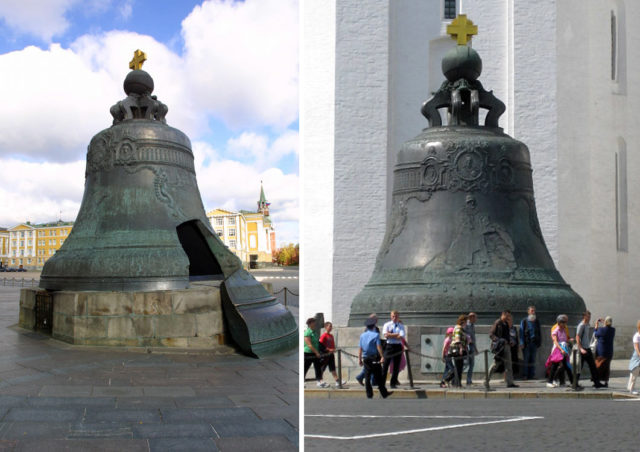
The broken Tsar Bell remained in the pit for almost 100 years after a fire in 1737 until it was raised and placed on a pedestal by Auguste de Montferrand. Photo Credit1 Photo Credit2
The bell is adorned with nearly life-sized images of Tsar Alexei Romanov and Tsarina Anna Ioannovna, along with plants, sacred images of saints, relief images of baroque angels, and two illustrations telling the story of the bell’s casting.
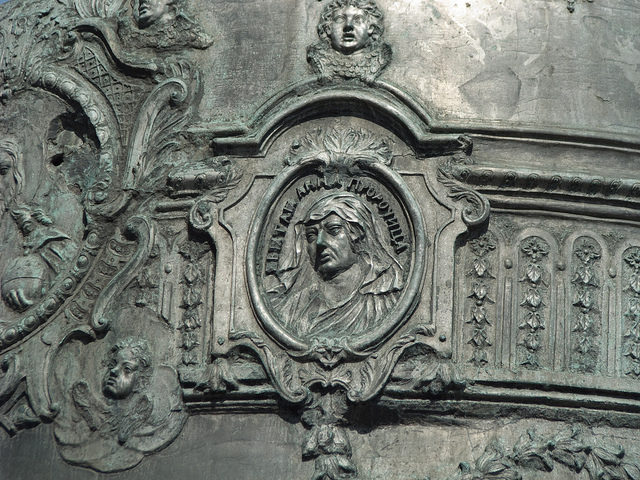
A portrait of the Empress Anna Ioannovna. Photo Credit
All the images and inscriptions were made by the Russian craftsmen P. Kohktev, V. Kobelev, P. Galkin, P. Serebryakov, and P. Lukovnikov.
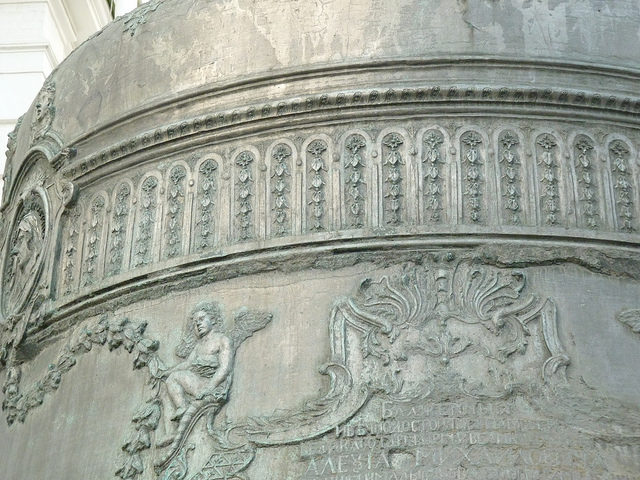
Decorated with inscriptions telling the story of the bell, images of angels and saints, and baroque style vegetation ornaments. Photo Credit
Other famous faces depicted on it include Jesus Christ, Virgin Mary, John the Baptist, and many Russian rulers. In Russia, bells were used not only to indicate church services; they also announced important ceremonies, coronations, celebrations, and were used as an alarm in case of fire or enemy attack.
Though the bell has never been rung, it’s believed that it would be heard at a distance of 30–40 miles if it was. Along with the Tsar Cannon, the largest bombard by caliber in the world, the Tsar Bell dominates Ivanovskaya Square in Moscow’s Kremlin



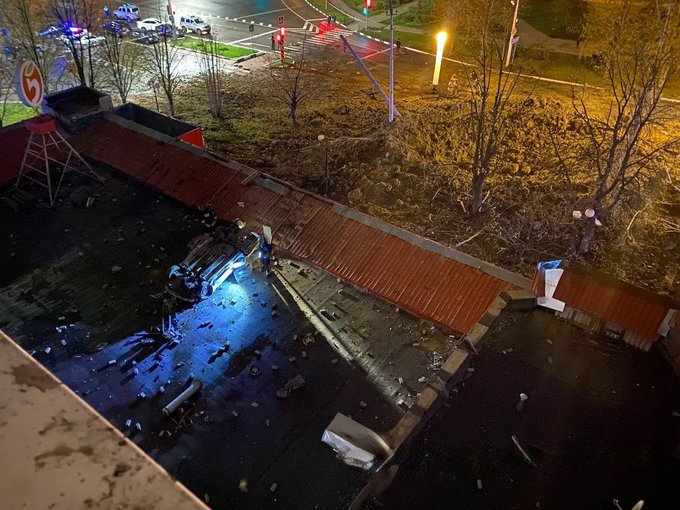






 on Twitter: “In Yeisk, Russia an explosion was reported near the airfield…
on Twitter: “In Yeisk, Russia an explosion was reported near the airfield… n 1471,
n 1471, 





 In occupied
In occupied 

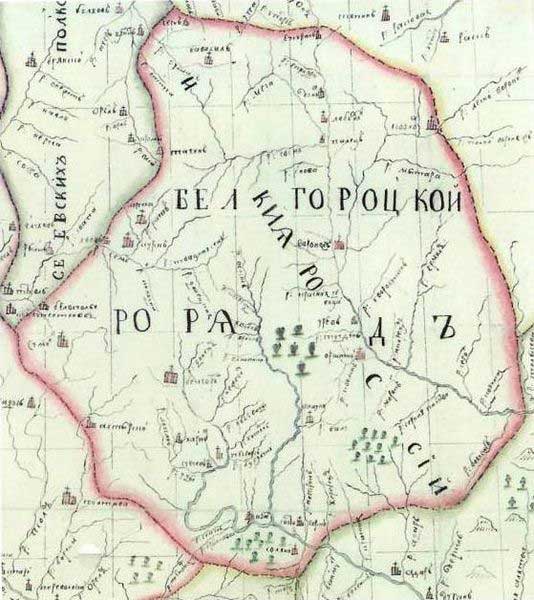
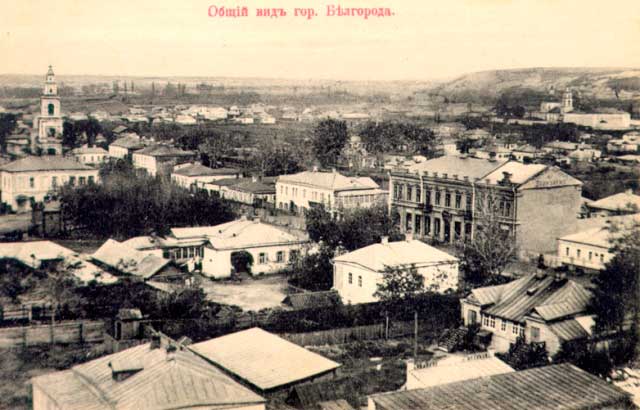 19th Century
19th Century
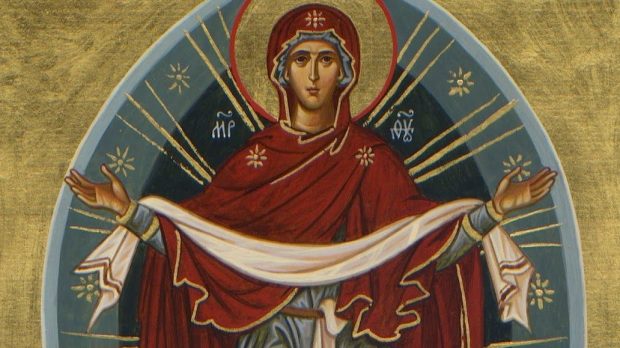

.svg/120px-Coat_of_Arms_of_Borisovka_(Belgorod_oblast).svg.png)






